

Johns Hopkins University (JHU) continues to pad its space community résumé with their interactive map, “The map of the observable Universe”, that takes viewers on a 13.7-billion-year-old tour of the cosmos from the present to the moments after the Big Bang. While JHU is responsible for creating the site, additional contributions were made by NASA, the European Space Agency, the National Science Foundation, and the Sloan Foundation.
by KEN KREMER on MAY 29, 2015
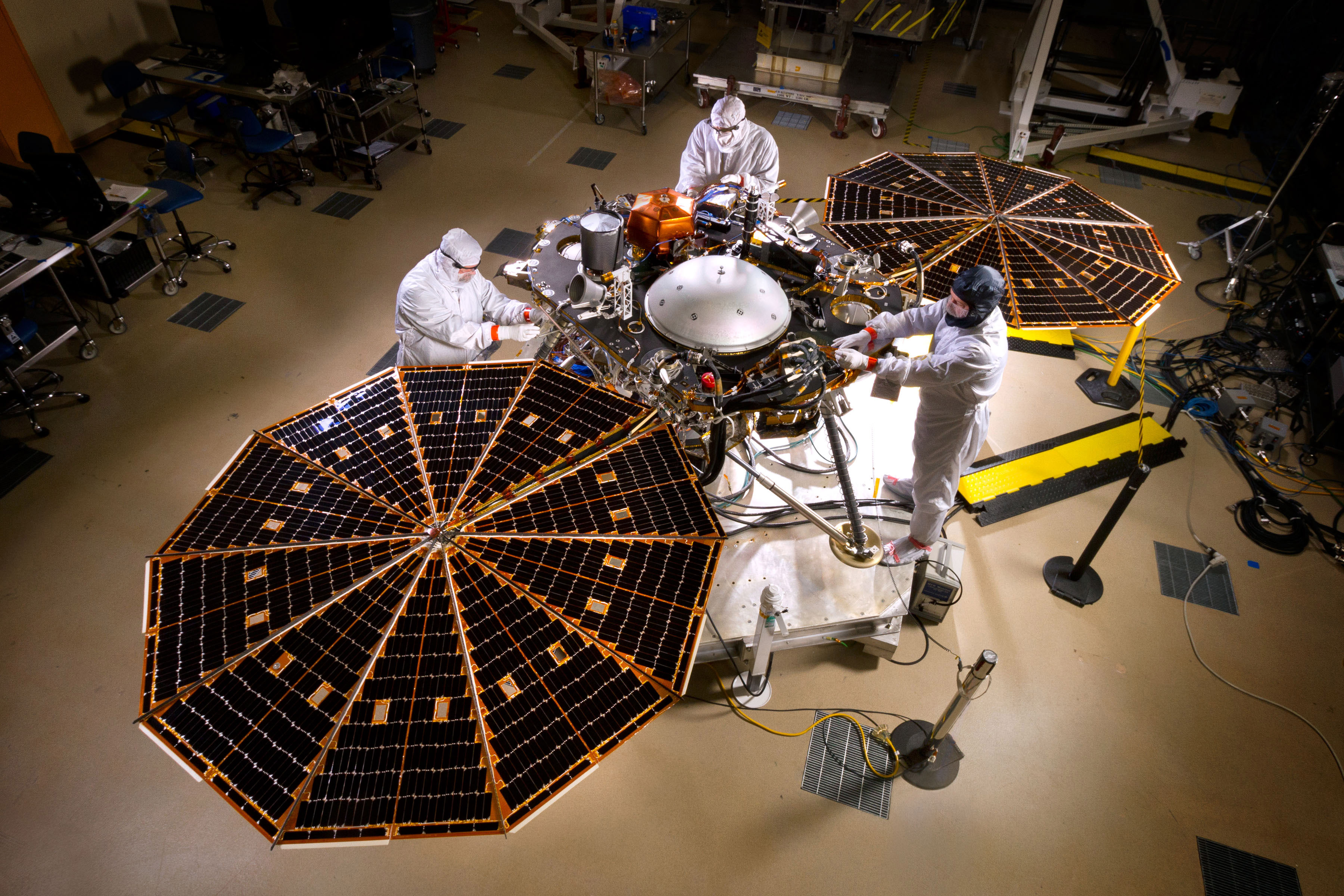
NASA’s InSight Mars lander spacecraft in a Lockheed Martin clean room near Denver(May 2015). As part of a series of deployment tests,
the spacecraft was commanded to deploy its solar arrays in the clean room to test and verify the exact process
that it will use on the surface of Mars.
CREDITS: NASA/JPL-Caltech/Lockheed Martin
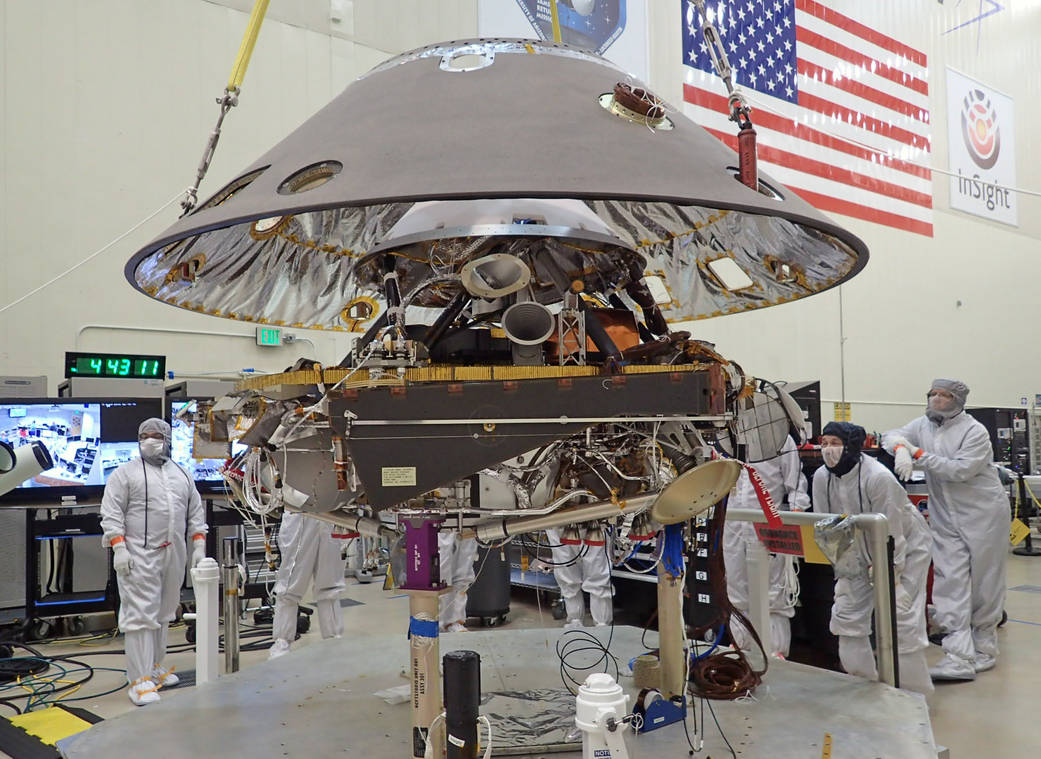
Back shell of NASA’s InSight spacecraft is being lowered onto the mission’s lander,
which is folded into its stowed configuration. The back shell and a heat shield form the aeroshell,
which will protect the lander as the spacecraft plunges into the upper atmosphere of Mars.
Launch now rescheduled to May 2018 to fix French-built seismometer.
Credit: NASA/JPL-Caltech/Lockheed Martin
By Paul Scott Anderson
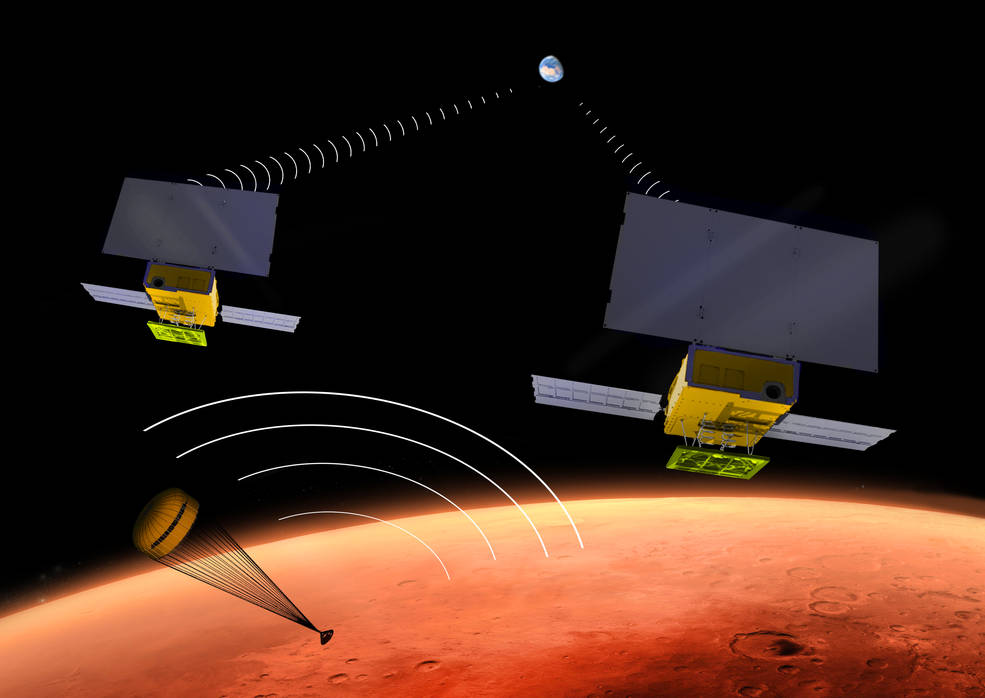
Artist’s conception of the MarCO CubeSats flying past Mars as the InSight lander descends to the surface. Image Credit: NASA/JPL-Caltech The next NASA mission to Mars, the InSight lander, will include some additional experimental technology:
the first deep-space CubeSats. Two small CubeSats will fly past the planet as the lander is descending through the atmosphere;
this will be the first time CubeSats have been used in an interplanetary mission.
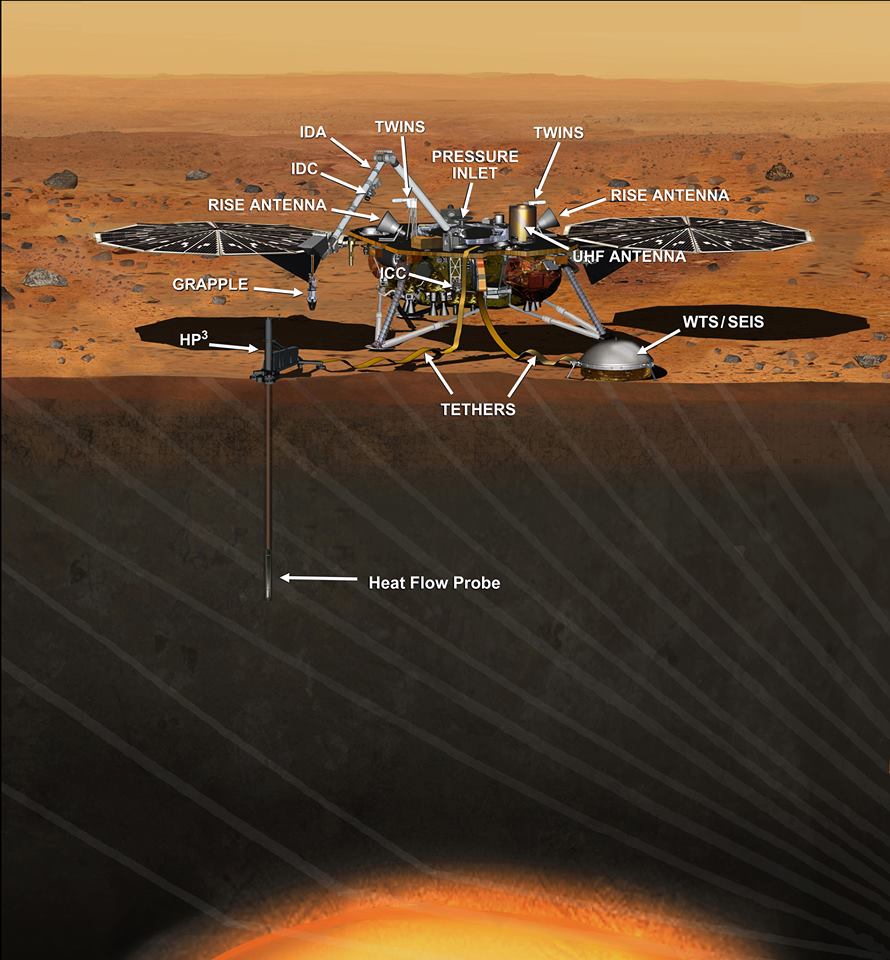
This artist’s concept depicts the InSight lander on Mars after the lander’s robotic arm has deployed
a seismometer and a heat probe directly onto the ground. InSight is the first mission dedicated to investigating
the deep interior of Mars. The findings will advance understanding of how all rocky planets, including Earth,
formed and evolved. NASA approved a new launch date in May 2018.
Credits: NASA/JPL-Caltech
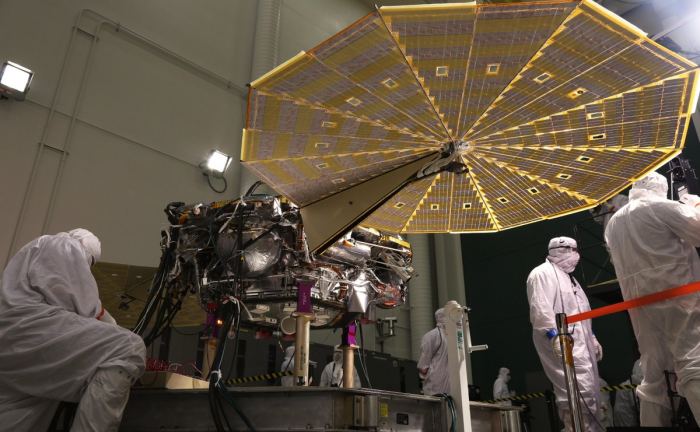
The Insight lander responds to commands to spread its solar arrays during a January 23, 2018 test at the Lockheed Martin clean room in Littleton, Colorado. Image: Lockheed Martin Space
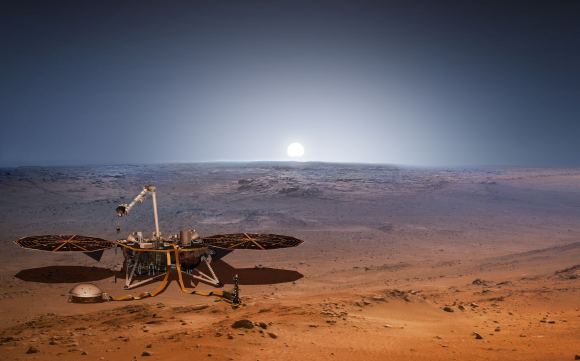
This artist’s illustration of InSight on a photo background of Mars shows the lander fully deployed. The solar arrays are open, and in the foreground two of its instruments are shown. On the left is the SEIS instrument, and on the right is the HP3 probe. Image: NASA/Lockheed Martin
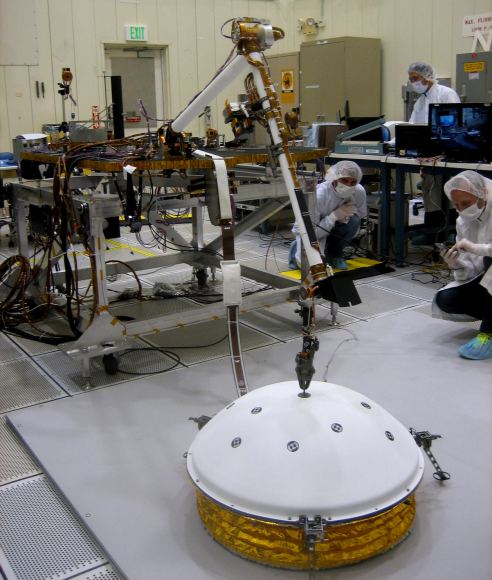
In this image, InSight’s Instrument Deployment Arm is practicing placing SEIS on the surface. Image: NASA/Lockheed Martin
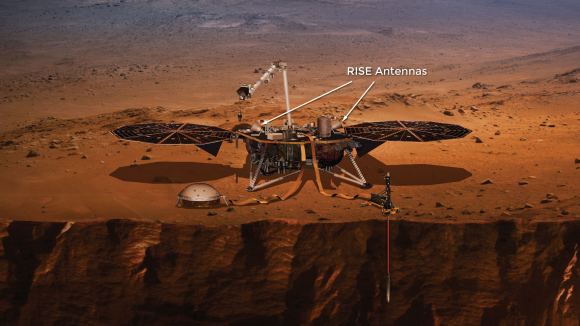
The two RISE antennae are shown in this image. RISE will reveal information about the Martian core by tracking InSight’s position while Mars orbits the Sun. Image: NASA/Lockheed Martin
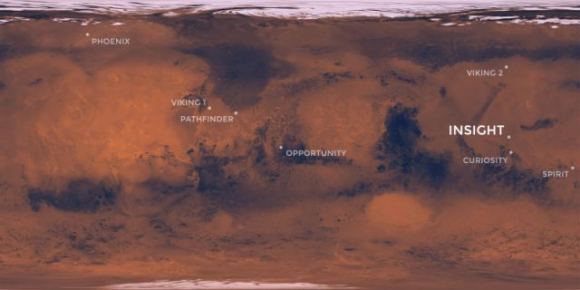
nSight will land at Elysium Planitia, just north of the Martian equator. Image: NASA/JPL-CalTech
Mission team members for InSight, the new Mars lander mission selected by NASA to launch in 2016, explain how the spacecraft will advance our knowledge of Mars' evolution.
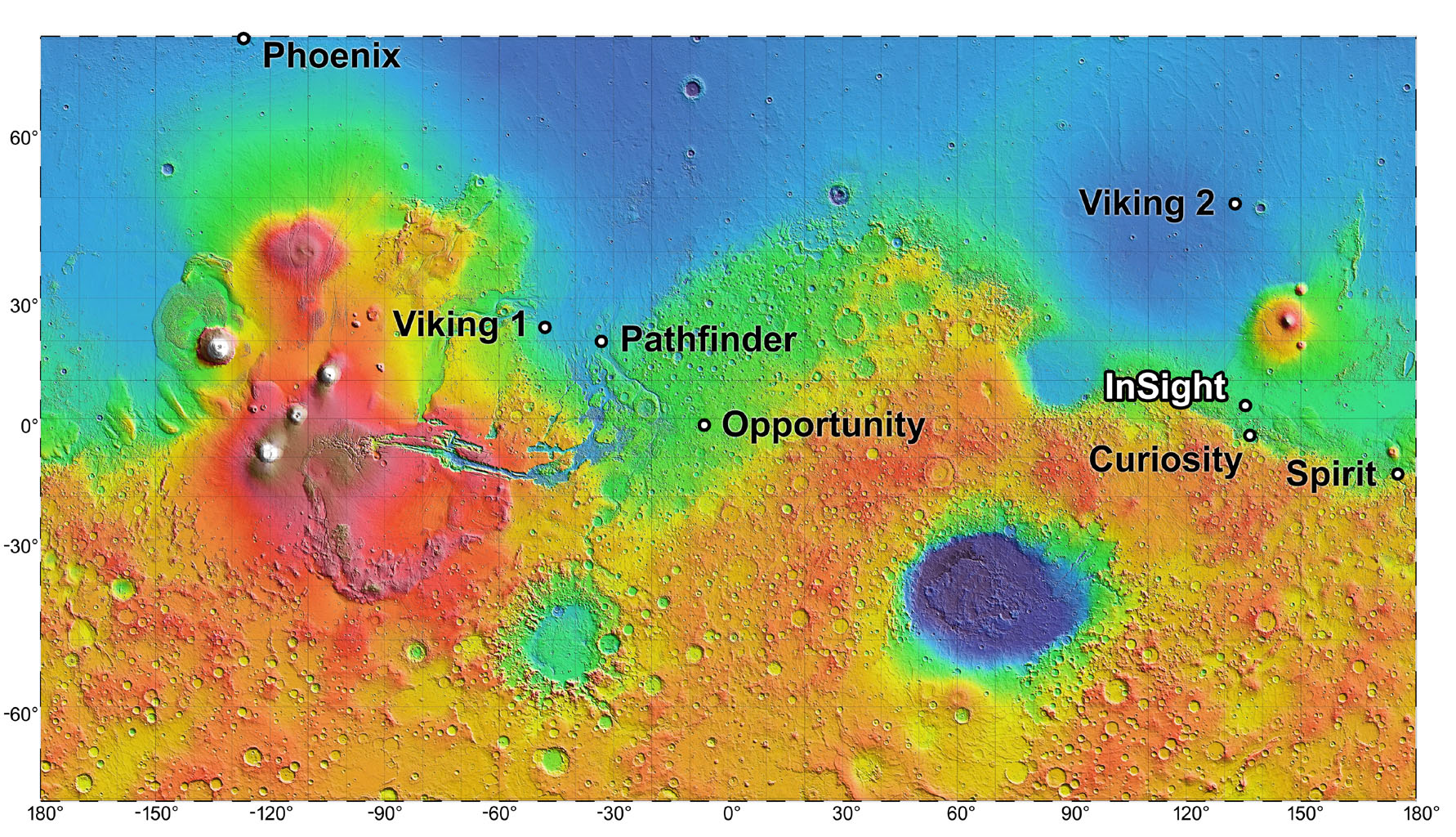
In the course of exploring Mars, the many landers, rovers and orbiters that have been sent there have captured some truly stunning images of the landscape. Between Spirit, Opportunity, Curiosity, the Mars Reconnaissance Orbiter (MRO) and others, we have treated to some high-definition images over the years of sandy dunes, craters and mountains – many of which call to mind places here on Earth.
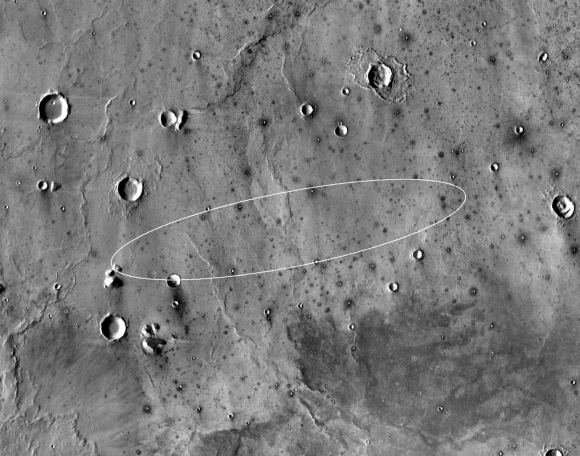
Smooth, flat ground dominates InSight’s landing ellipse in the Elysium Planitia region of Mars. Credit: NASA/JPL-Caltech/ASU
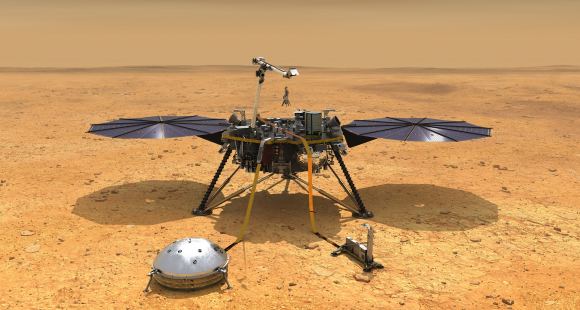
This artist’s concept depicts the smooth, flat ground that dominates InSight’s landing ellipse in the Elysium Planitia region of Mars. Credit: NASA/JPL-Caltech
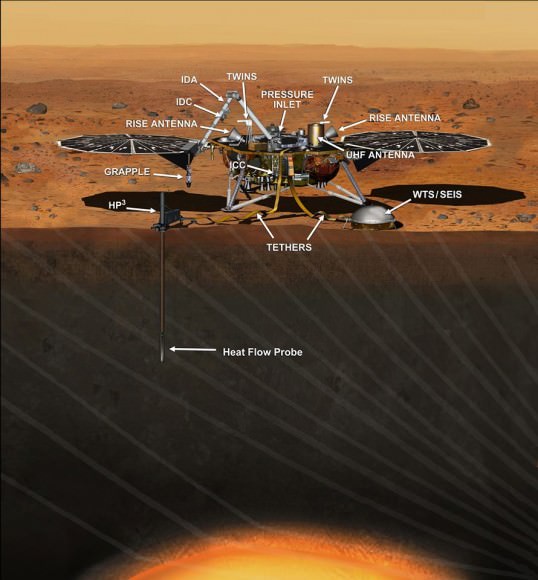
This artist’s concept depicts the InSight lander on Mars after the lander’s robotic arm has deployed a seismometer and a heat probe directly onto the ground. Credits: NASA/JPL-Caltech
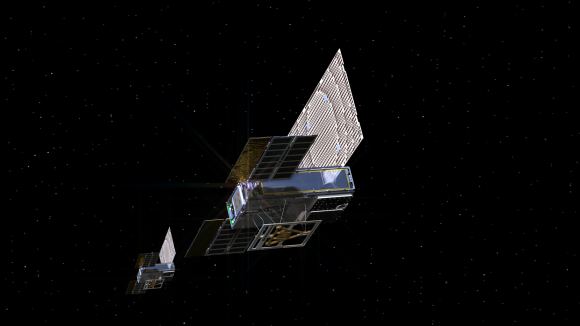
An artist’s rendering of the twin Mars Cube One (MarCO) spacecraft as they fly through deep space. Credit: NASA/JPL-Caltech
NASA's next mission to Mars is weeks away from its May 2018 launch. InSight is more than a Mars mission. Its team members hope to unlock the mysteries of the formation and evolution of rocky planets, including Earth. For more about the mission, visit
NASA's Interior Exploration using Seismic Investigations, Geodesy and Heat Transport (InSight) lander successfully touched down on the Red Planet after an almost seven-month, 300-million-mile (458-million-kilometer) journey from Earth. "We hit the Martian atmosphere at 12,300 mph (19,800 kilometers per hour), and the whole sequence to touching down on the surface took only six-and-a-half minutes," said InSight project manager Tom Hoffman at NASA’s Jet Propulsion Laboratory. "During that short span of time, InSight had to autonomously perform dozens of operations and do them flawlessly – and by all indications that is exactly what our spacecraft did." InSight will operate on the surface for one Martian year, plus 40 Martian days, or sols, until Nov. 24, 2020. The mission objectives of the two small MarCOs which relayed InSight's telemetry was completed after their Martian flyby. For more info, see
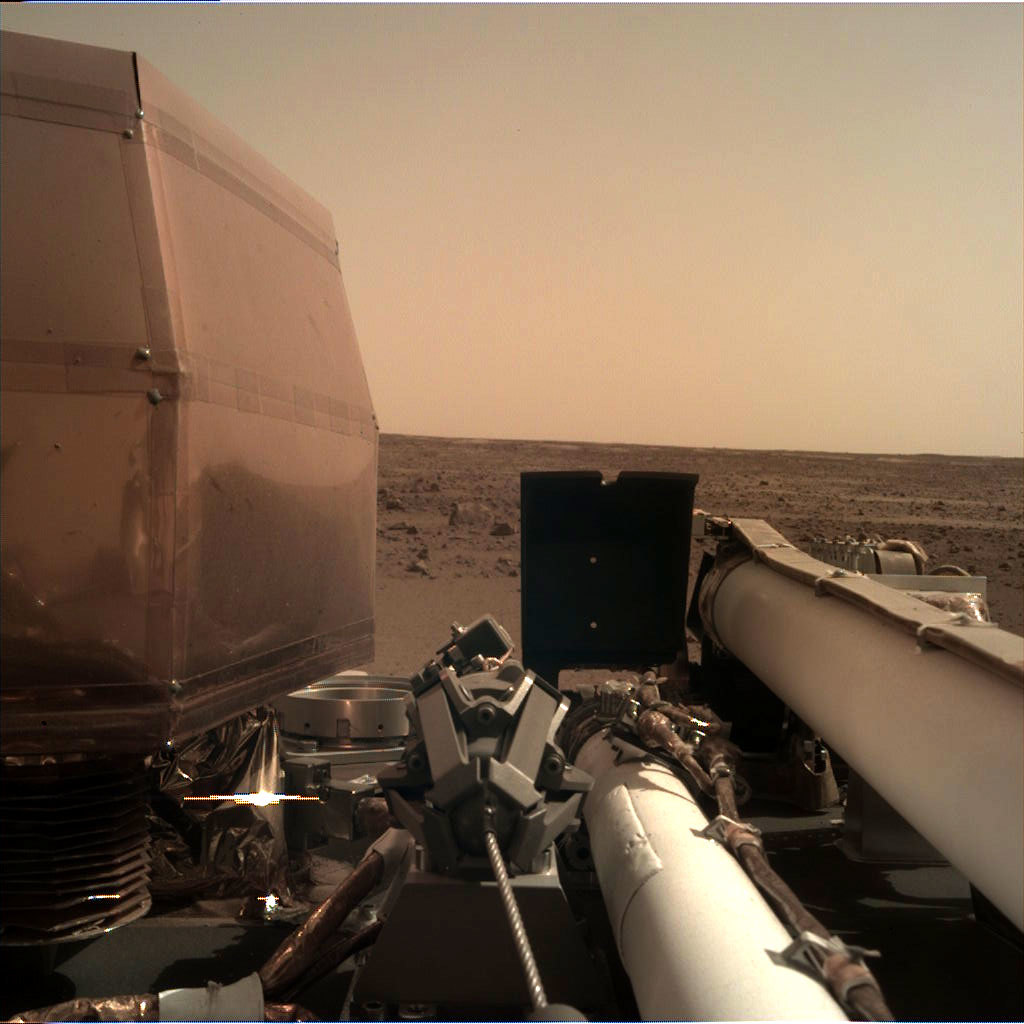
Yesterday, NASA’s Interior Exploration using Seismic Investigations, Geodesy and Heat Transport (InSight) lander reached Mars after a seven months journey. NASA broadcast the landing live, showing the mission control team eagerly watching as the spacecraft entered the Martian atmosphere and began the nail-biting entry, descent and landing (EDL) process.
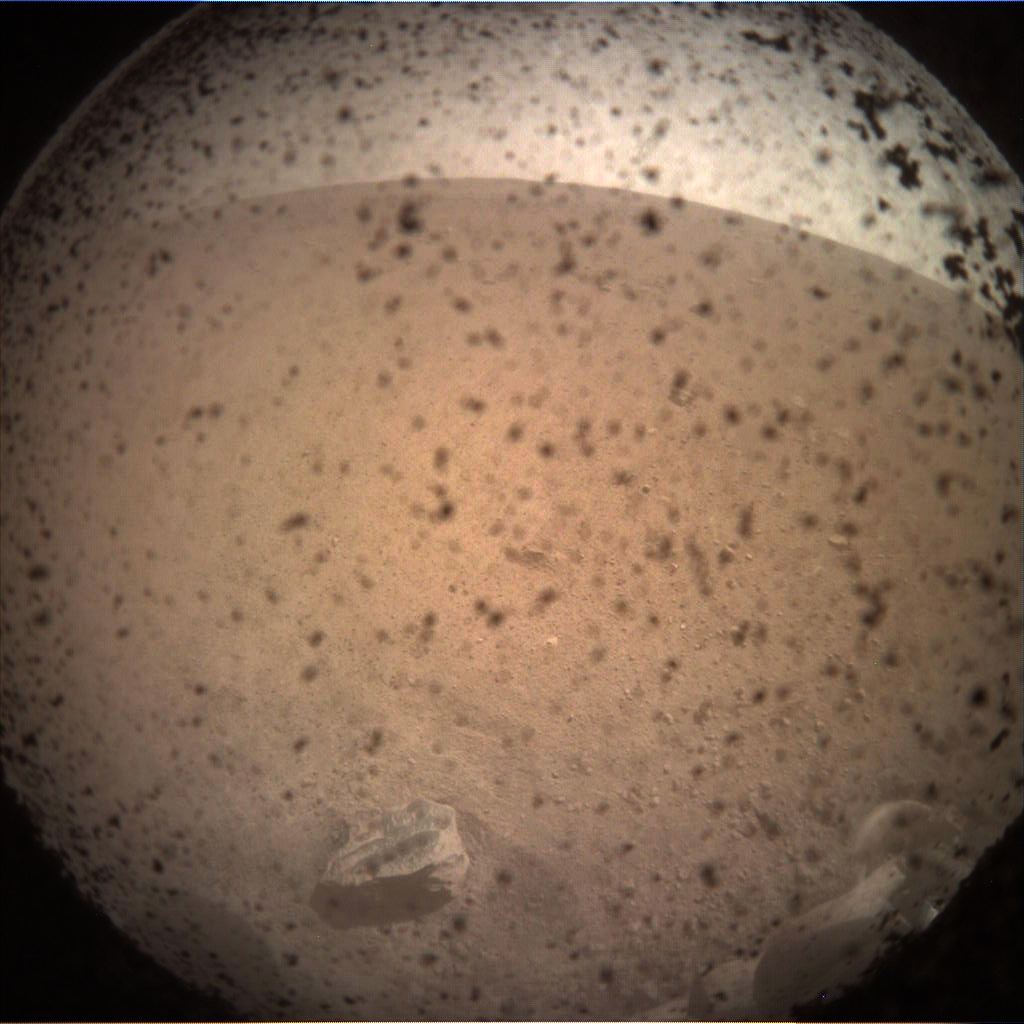
Image of the area in front of insight, taken using its ICC. Credit: NASA/JPL-Caltech
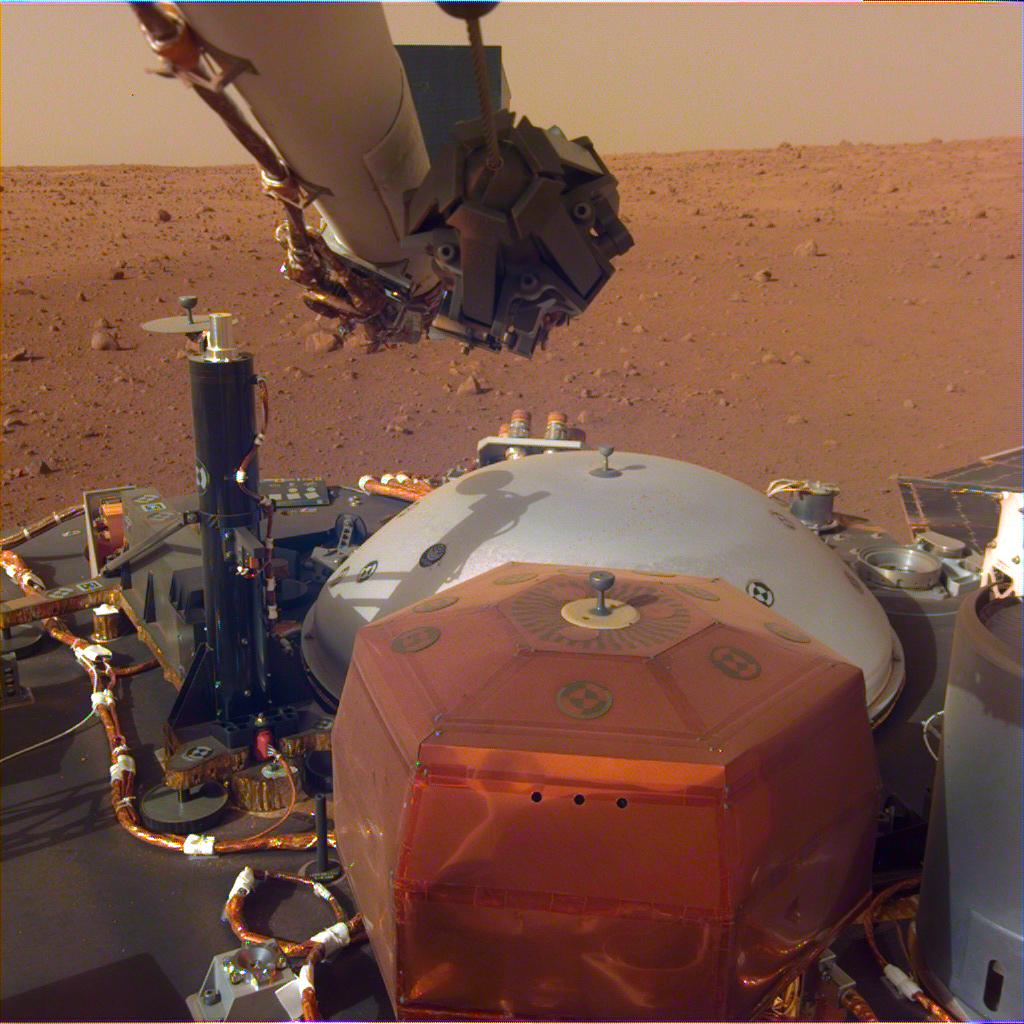
This image was taken by the InSight Lander’s Instrument Deployment Camera mounted on the lander’s robotic arm. The stowed grapple on the end of the arm is folded in, but it will unfold and be used to deploy the lander’s science instrument. The copper-colored hexagonal object is the protective cover for the seismometer, and the grey dome behind it is a wind and thermal shield, which will be placed over the seismometer after its deployed. The black cyliner on the left is the heat probe, which will drill up to 5 meters into the Martian surface. Image: NASA/JPL-Caltech
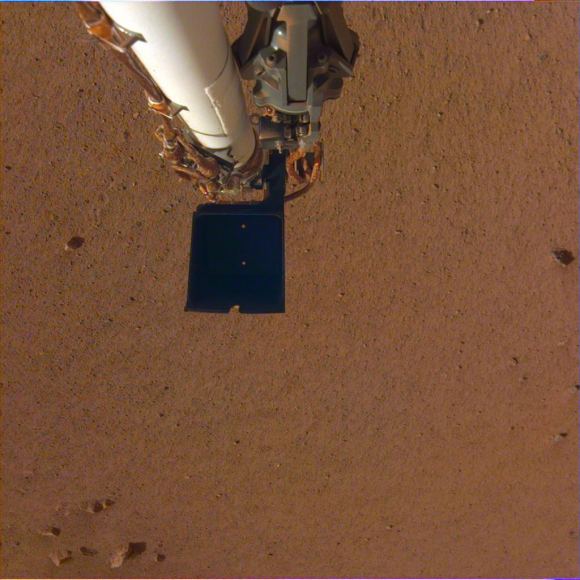
This image was captured by InSight’s Instrument Deployment Camera taken while the camera still had its transparent protective dust cover in place. It shows the grapple in stowed position, and the dark scoop at the end of the arm. The five-fingered grapple is used to deploy the instruments on the Martian surface. Image: NASA/JPL-Caltech
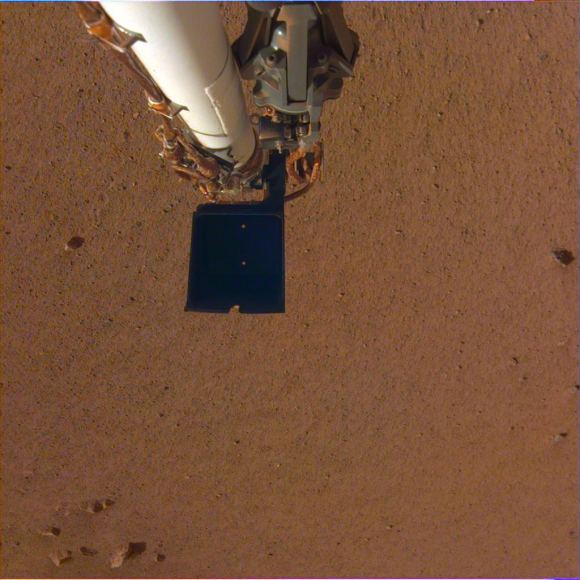
This image was captured by InSight’s Instrument Deployment Camera taken while the camera still had its transparent protective dust cover in place. It shows the grapple in stowed position, and the dark scoop at the end of the arm. The five-fingered grapple is used to deploy the instruments on the Martian surface. Image: NASA/JPL-Caltech
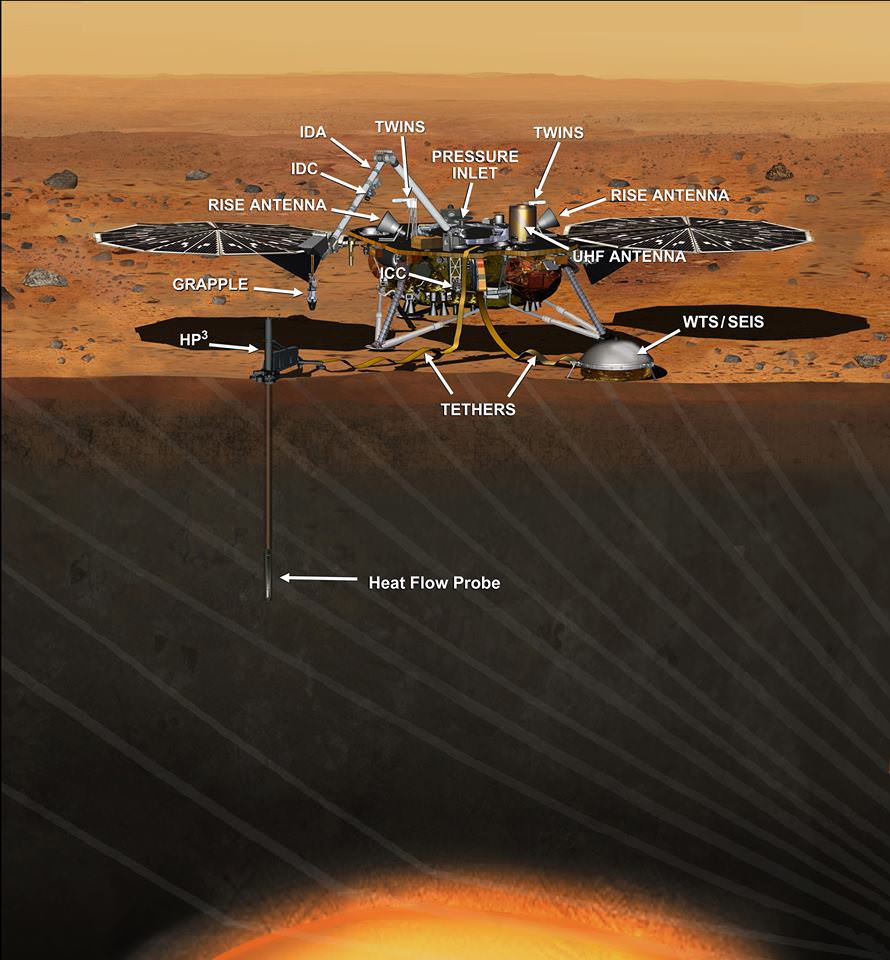
This artist’s concept depicts the InSight lander on Mars after the lander’s robotic arm has deployed a seismometer and a heat probe directly onto the ground. Credits: NASA/JPL-Caltech
More Audible Sounds from InSight's Seismometer on Mars Listen to data from the seismometer on NASA's InSight spacecraft of vibrations caused by Martian wind moving over the lander's solar panels. In this version, the data have been processed to raise the frequencies by two octaves to make them more audible. Both the processed and unprocessed audio are available for download at nasa.gov/sounds. JPL manages InSight for NASA's Science Mission Directorate. InSight is part of NASA's Discovery Program, managed by the agency's Marshall Space Flight Center in Huntsville, Alabama. France’s national space agency, Centre National d’Études Spatiales (CNES), leads the consortium that provided SEIS. The principal investigator for SEIS is Philippe Lognonné of the Institute of Earth Physics of Paris (Institut de Physique du Globe de Paris, or IPGP). Imperial College London and Oxford University made the short-period sensors. For more information on the InSight mission, visit Credit: NASA/JPL-Caltech/CNES/UKSA/Imperial College London/Oxford/ETH
Listen to raw, unprocessed data from the seismometer on NASA's InSight spacecraft of vibrations caused by wind moving over the solar panels on Mars. A subwoofer or earphones are needed to hear this clip. The sounds were recorded by two of the three short-period sensors on the seismometer (SEIS). The audio is available for download at NASA.gov/sounds . JPL manages InSight for NASA's Science Mission Directorate. InSight is part of NASA's Discovery Program, managed by the agency's Marshall Space Flight Center in Huntsville, Alabama. France’s national space agency, Centre National d’Études Spatiales (CNES), Paris, leads the consortium that provided SEIS. The principal investigator for SEIS is Philippe Lognonné of the Institute of Earth Physics of Paris (Institut de Physique du Globe de Paris, or IPGP). Imperial College, London, and Oxford University made the short-period sensors. For more information on the InSight mission, visit Credit: NASA/JPL-Caltech/CNES/UKSA/Imperial College London/Oxford/ETH
Listen to data from the air pressure sensor on NASA's InSight lander, indicating wind blowing by on Mars. The data were sped up by a factor of 100, shortening the duration of the recording and shifting it up in frequency 100 times (a little more than six octaves). The audio is available for download at NASA.gov/sounds. JPL manages InSight for NASA's Science Mission Directorate. InSight is part of NASA's Discovery Program, managed by the agency's Marshall Space Flight Center in Huntsville, Alabama. For more information on the InSight mission, visit Credit: NASA/JPL-Caltech/CNES/Cornell
Original air date: Dec. 7, 2018 at 12:30 p.m. ET (9:30 a.m. PT, 1630 UTC) More information on the story is available at Associated graphics, images and audio files will be available at starting at 12:30 p.m. EST and will also appear in this broadcast. The teleconference panelists will be: Bruce Banerdt, InSight Principal Investigator, NASA’s Jet Propulsion Laboratory Thomas Pike, Short Period Seismometer Science Lead, Imperial College, London Don Banfield, Auxiliary Payload Sensor Subsystem (APSS) Science Lead, Cornell University Lori Glaze, Acting Director of Planetary Science, NASA HQ Supporting visuals will be available at Follow us @NASAJPL to find out our next scheduled event.
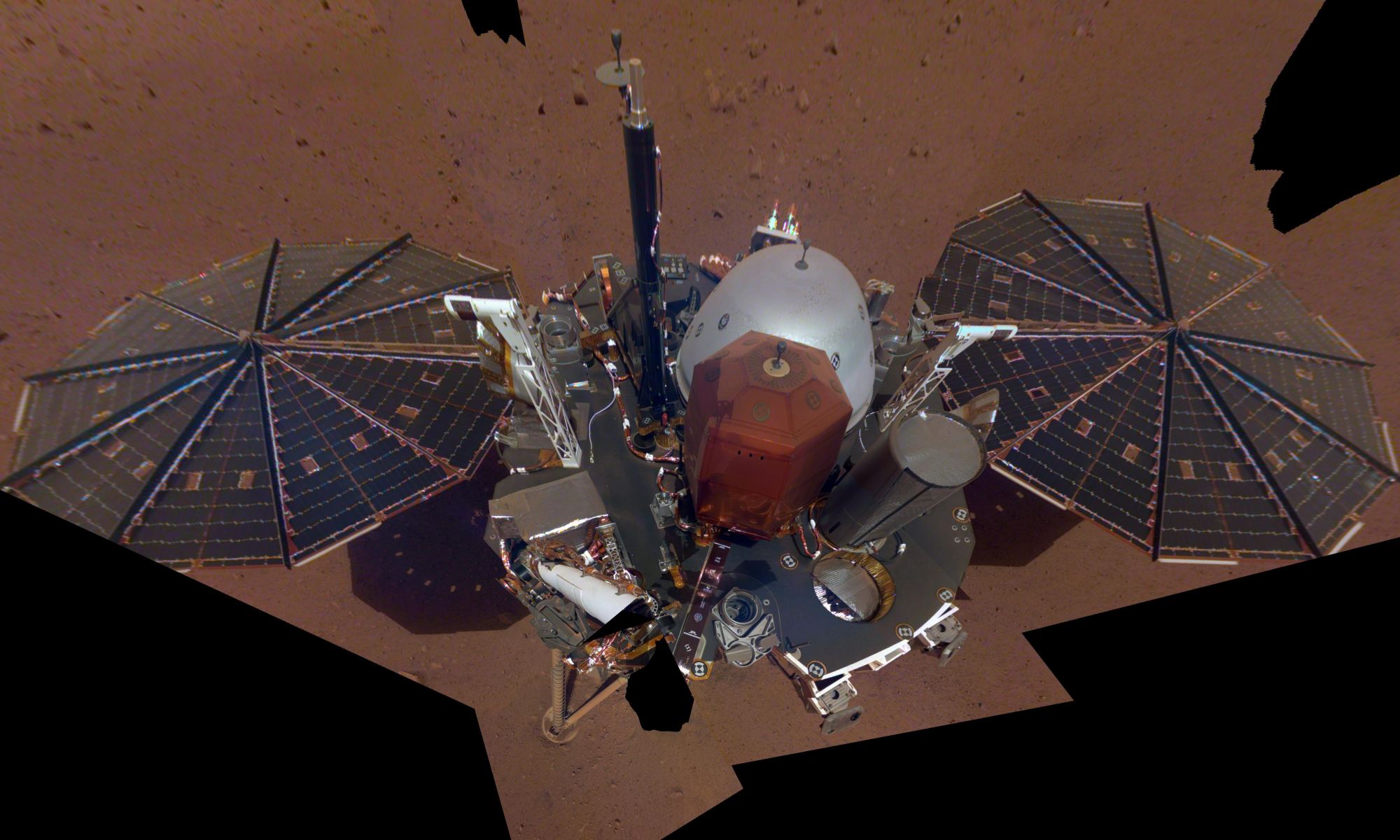
InSight’s first full selfie on Mars. The selfie was taken on Dec. 6th, and is a mosaic of 11 images taken with its Instrument Deployment Camera on the elbow of its robotic arm. Image Credit: NASA/JPL-Caltech
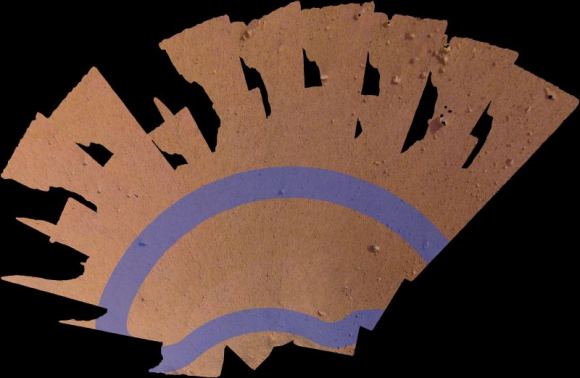
This mosaic of 52 images shows the InSight lander’s workspace, released at the same time as InSight’s first selfie. The lavender outline shows the area where SEIS and HP3 will be deployed. The area is about 4m x 2m, (14 ft x 7 ft), and shows the limitations for instrument placement by the Instrument Placement Arm. Image Credit: NASA/JPL-Caltech
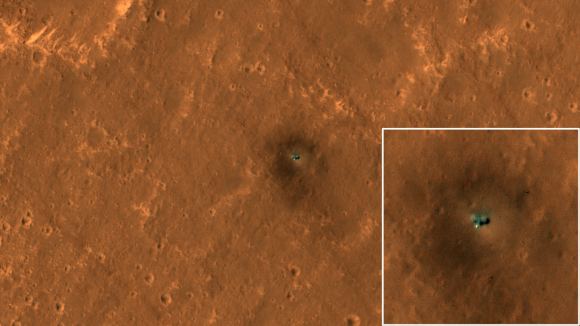
The InSight lander as imaged by the HiRISE camera on the MRO. InSight, of course, is not a rover, so there’s no tracks.
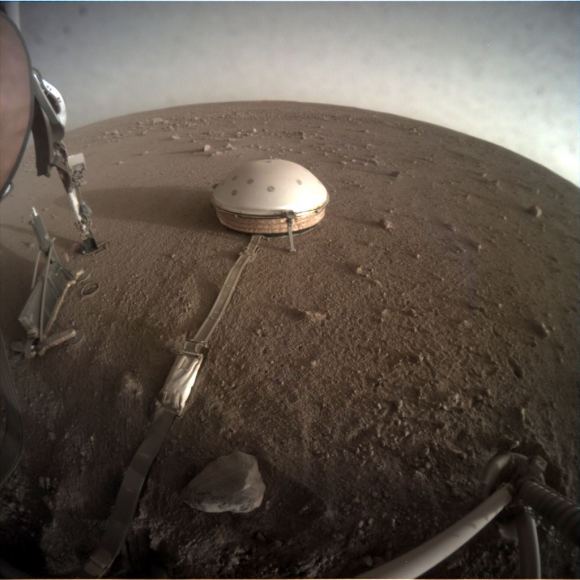
InSight’s SEIS instrument with its protective dome-shaped cover. The cover is clearly visible in the MRO image. Image Credit: NASA/JPL-Caltech
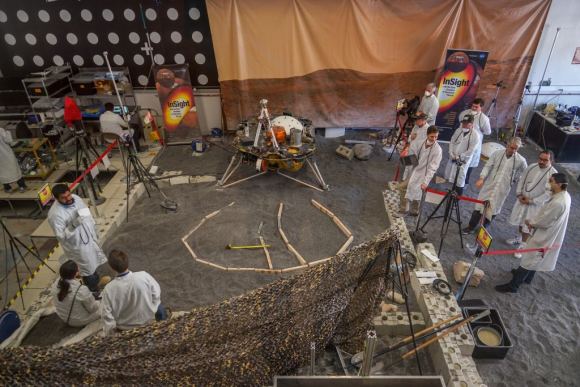
At the InSight lander test-bed facility at JPL, engineers sculpt a gravel-like material into a replica of InSight’s landing site on Mars. The wood marks the boundaries of the lander’s instrument placement zone. Image Credit: NASA/JPL-Caltech/IPGP
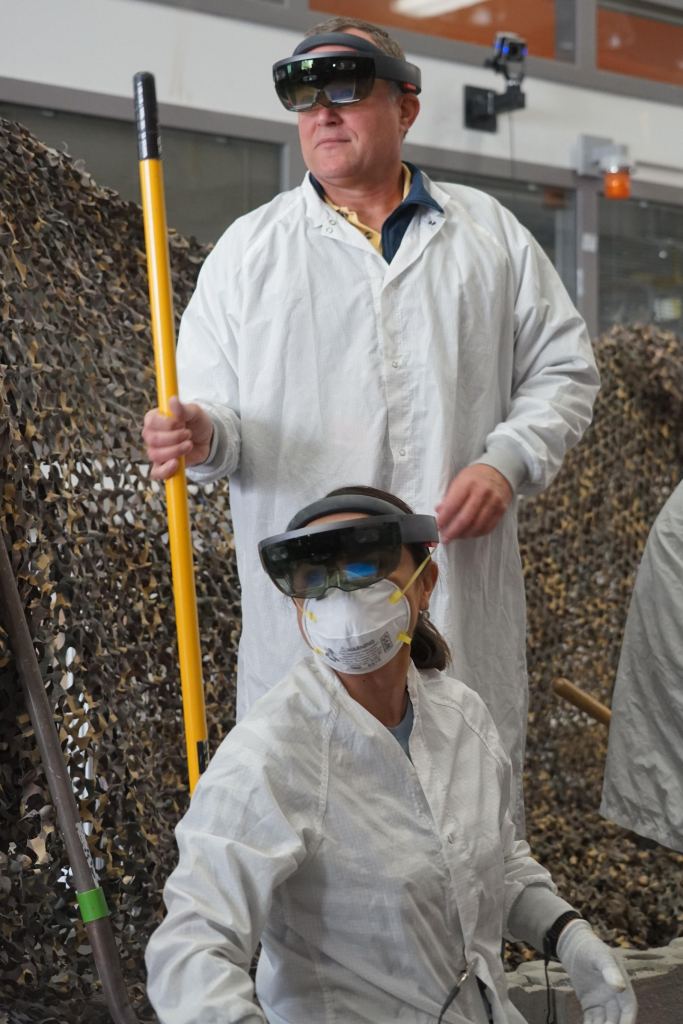
nSight Project Manager Tom Hoffman (standing) and engineer Marleen Sundgaard wear Microsoft HoloLens augmented reality headsets, which project digital terrain models of InSight’s landing location on Mars over the test-bed. Image Credit: NASA/JPL-Caltech/IPGP
According to the InSight team, placement of SEIS was critical to mission success. InSight has other instruments, but a failed placement would’ve hampered the mission significantly. There’s still some work required to level the seismometer. It’s sitting on ground that is tilted about 2 or 3 degrees. Once it’s levelled, data should start flowing.
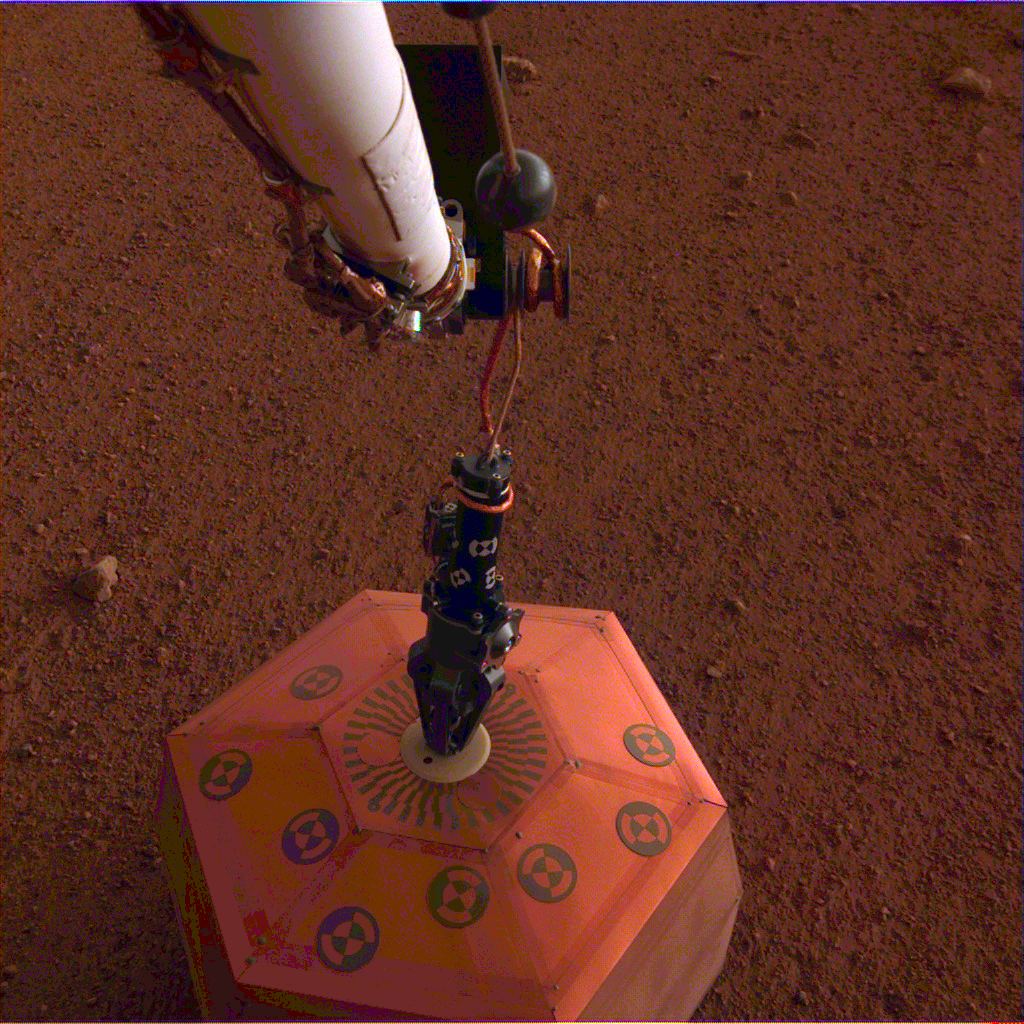
NASA’s Mars InSight lander has deployed its seismometer on the surface of Mars, marking an important milestone for the mission. Image Credit: NASA/JPL-Caltech
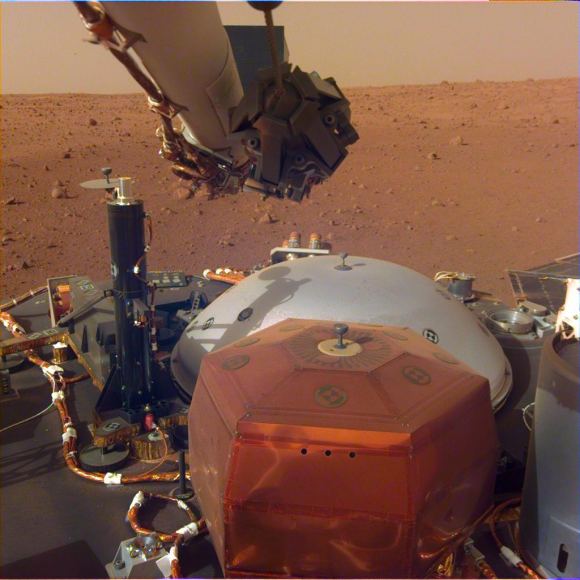
This image was taken by the InSight Lander’s Instrument Deployment Camera mounted on the lander’s robotic arm. The stowed grapple on the end of the arm is folded in, but it will unfold and be used to deploy the lander’s science instrument. The copper-colored hexagonal object is the protective cover for the seismometer, and the grey dome behind it is a wind and thermal shield, which will be placed over the seismometer after its deployed. The black cyliner on the left is the heat probe, which will drill up to 5 meters into the Martian surface. Image: NASA/JPL-Caltech
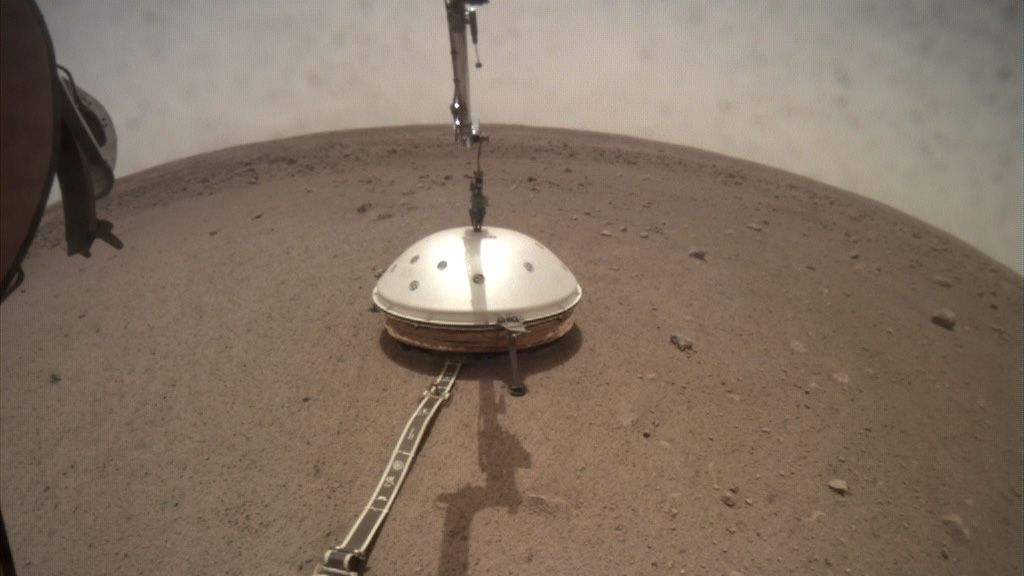
NASA’s InSight lander arrived on Mars on November 26th, 2018. Since then, it’s been busying itself studying its landing spot, and taking its time to carefully place its instruments. It spent several weeks testing the seismometer and adjusting it, and now it’s placed the domed, protective shield over the instrument.
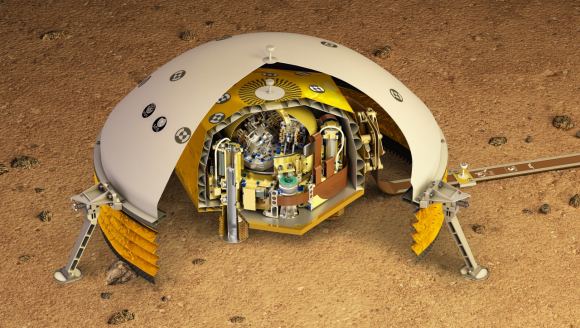
A cut-away view of SEIS. Image Credit: IPGP/David Ducros
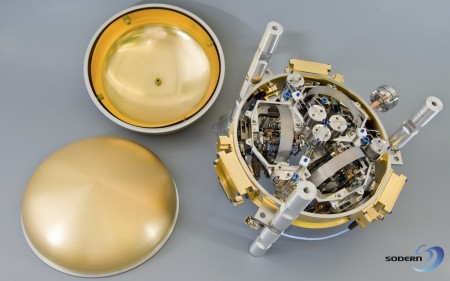
The SEIS instrument. All the electronics and mechanical parts are sealed inside a vacuum sphere of titanium. Image Credit: IPGP/SODERN
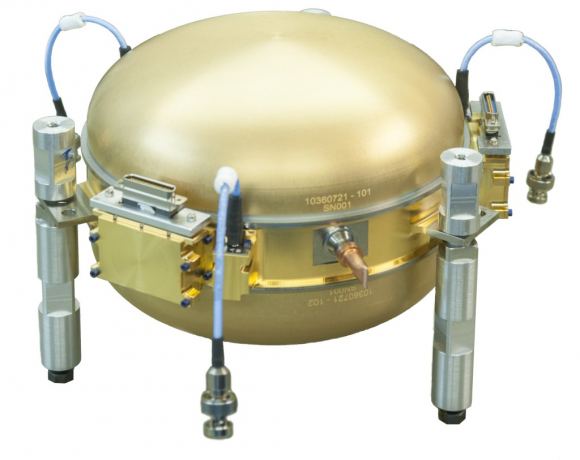
The SEIS instrument inside its vacuum sphere. Image Credit: IPGP/SODERN/CNES/Piraud
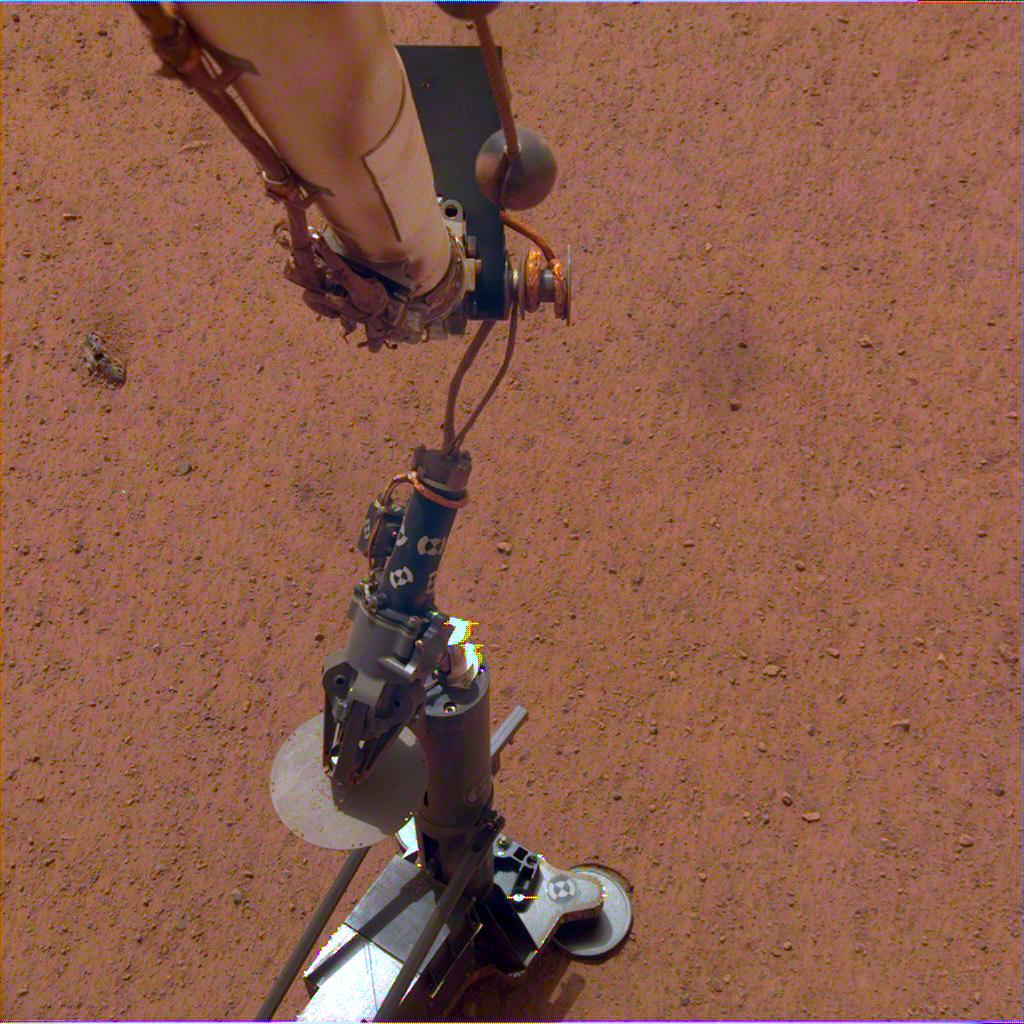
NASA’s InSight lander has finally placed its heat probe on the surface of Mars. The Heat Flow and Physical Properties Package (HP3) was deployed on February 12th, 2019 about one meter(3 ft 3inches) away from SEIS, the landers seismometer. Soon it’ll start hammering its way into the Martian soil.
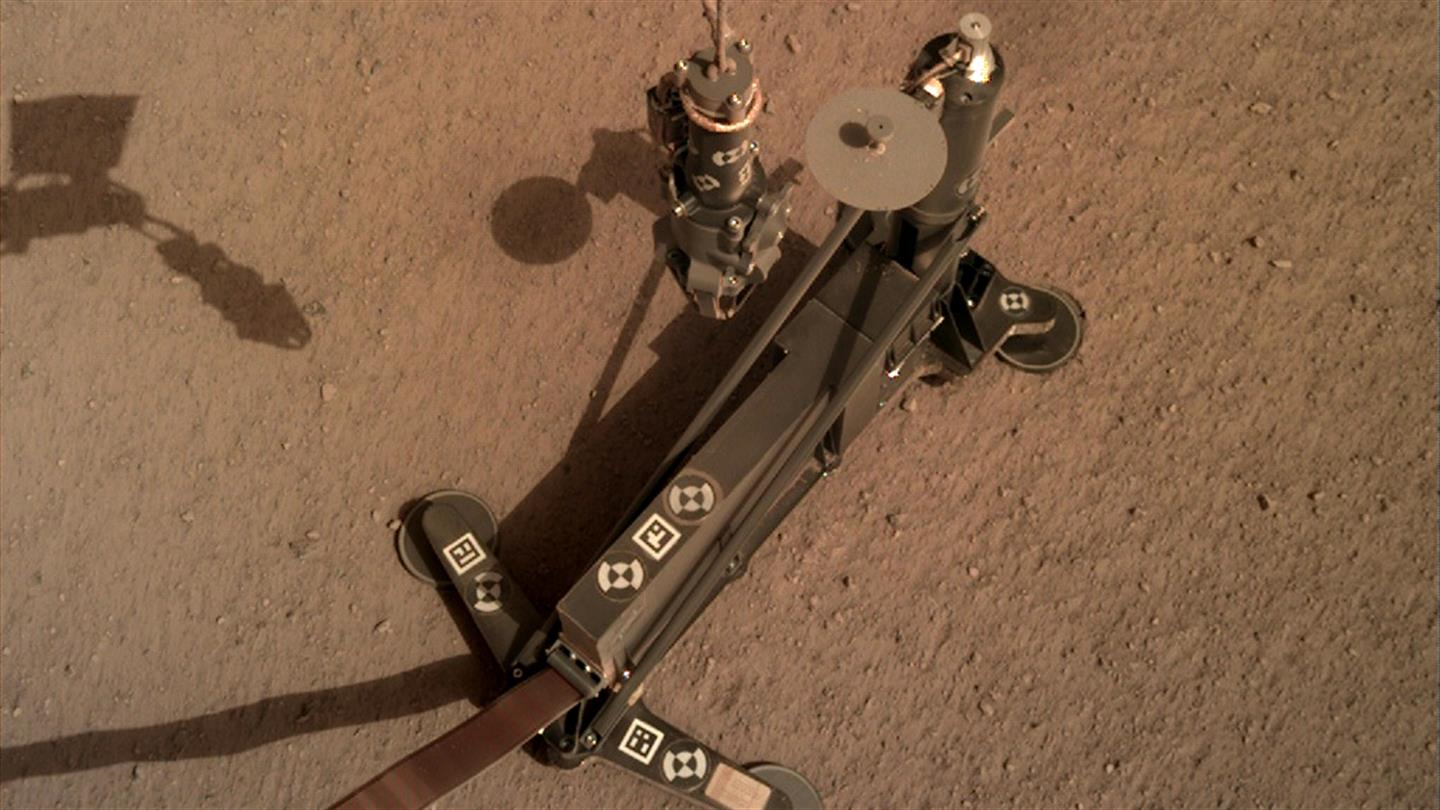
NASA’s InSight lander is busy deploying its Heat Flow and Physical Properties Package (HP3) into the Martian soil and has encountered some resistance. The German Aerospace Center (DLR), who designed and built the HP3 as part of the InSight mission, has announced that the instrument has hit not one, but two rocks in the sub-surface. For now the HP3 is in a resting phase, and it’s not clear what will happen next.
For the first time since the astronaut mission Apollo 17 in 1972, heat flow measurements will be carried out on another celestial body using a drilling mechanism. The main aim of the experiment is to be able to determine the thermal state of the interior of Mars using thermal flow measurements taken beneath the surface. Models of Mars’ formation, chemical composition and inner structure can be checked and refined on the basis of this data. The measurements from Mars can also be used to draw conclusions about Earth’s early development. Details : Download of the animation(s) in 4K/UHD on our Vimeo channel:
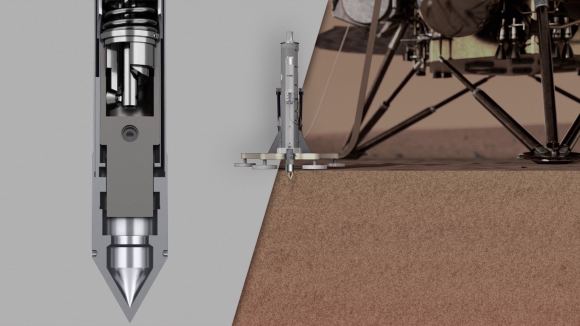
An illustration of the HP3 with a close-up of the mole on the left. Image Credit: DLR (CC-BY 3.0)
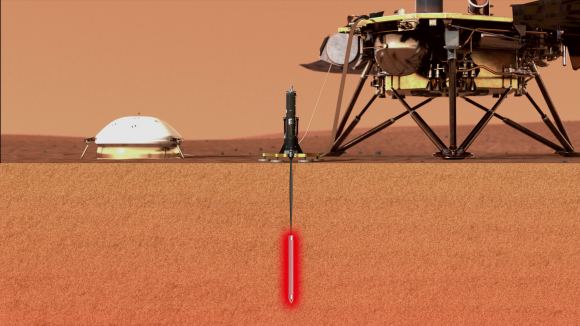
The mole measures the thermal conductivity of the Martian soil and can penetrate as deep as five meters to do so. Image Credit: DLR (CC-BY 3.0)
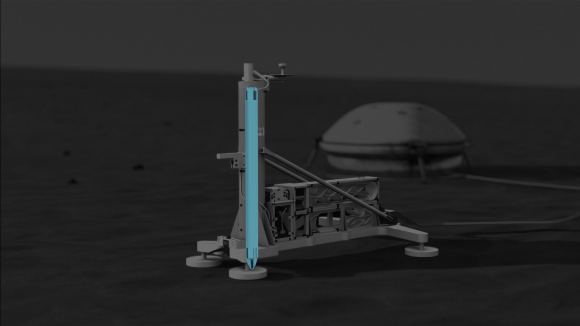
An illustration of the HP3 on the Martian surface. The mole penetrator is highlighted in blue. Image Credit: DLR (CC-BY 3.0)
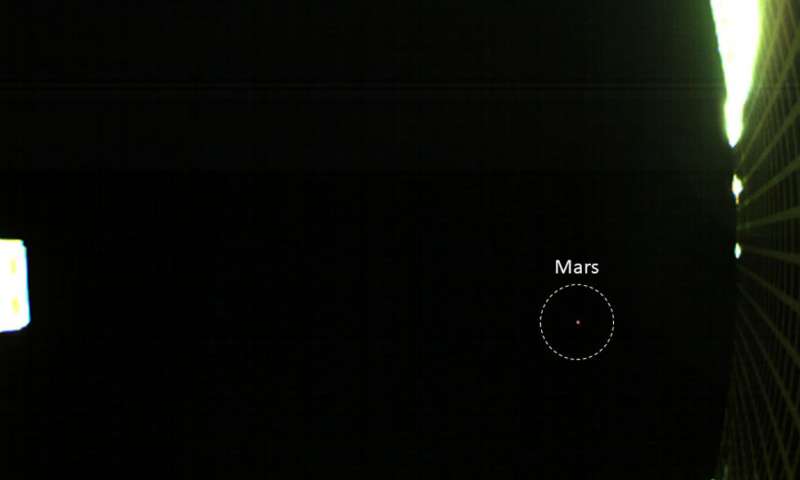
One of NASA's twin MarCO spacecraft took this image of Mars on October 2—the first time a CubeSat, a kind of low-cost, briefcase-sized spacecraft—has done so. Credit: NASA/JPL-Caltech Read more at: Phys.org's article
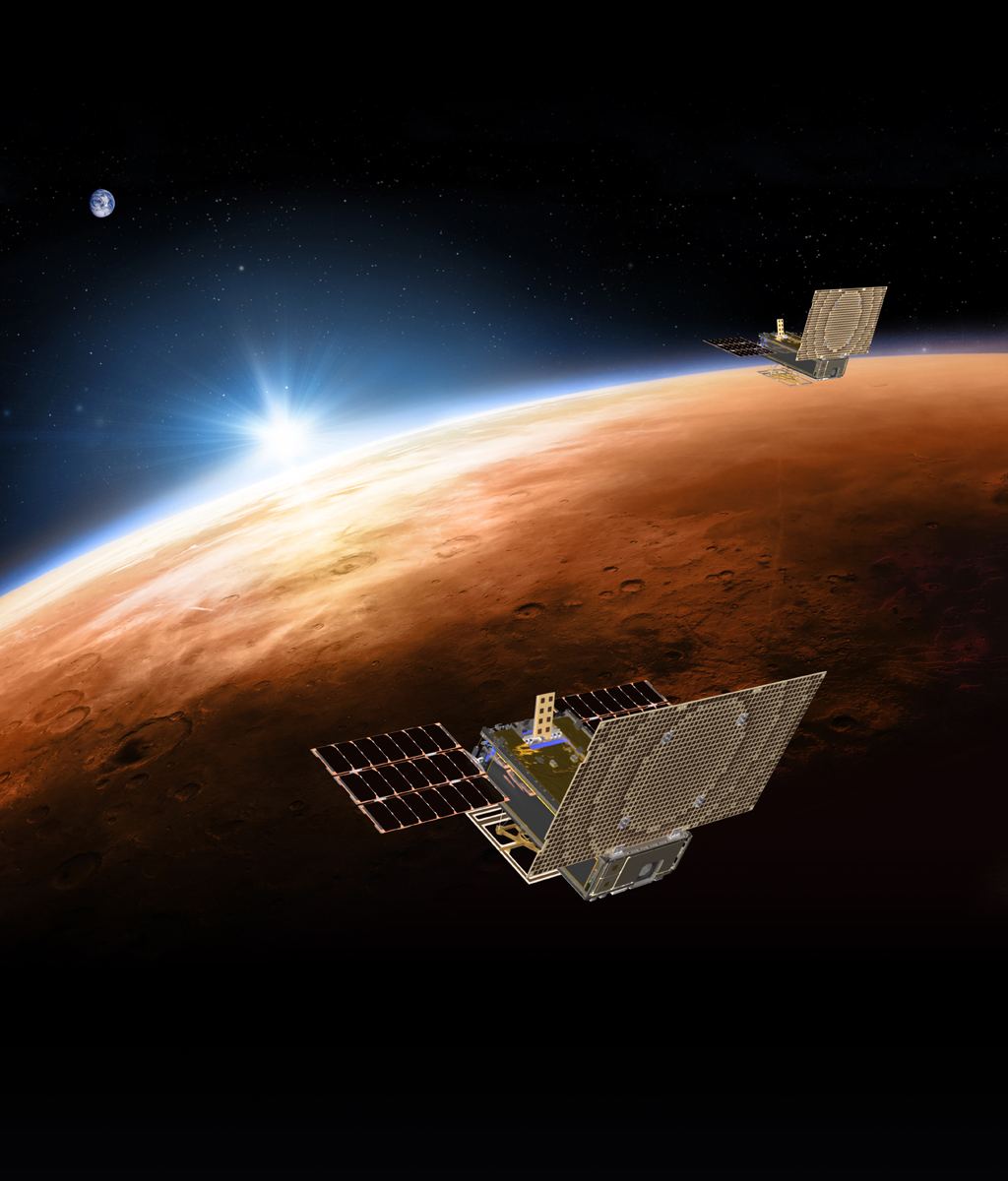
In the midst of all that, another major accomplishment received only passing attention. This was the Mars Cube One (MarCO) mission, an experiment conducted by NASA to see if two experimental CubeSats could survive the trip to deep space. Not only did these satellites survive the journey, they managed to relay communications from the lander and even took some pictures of their own
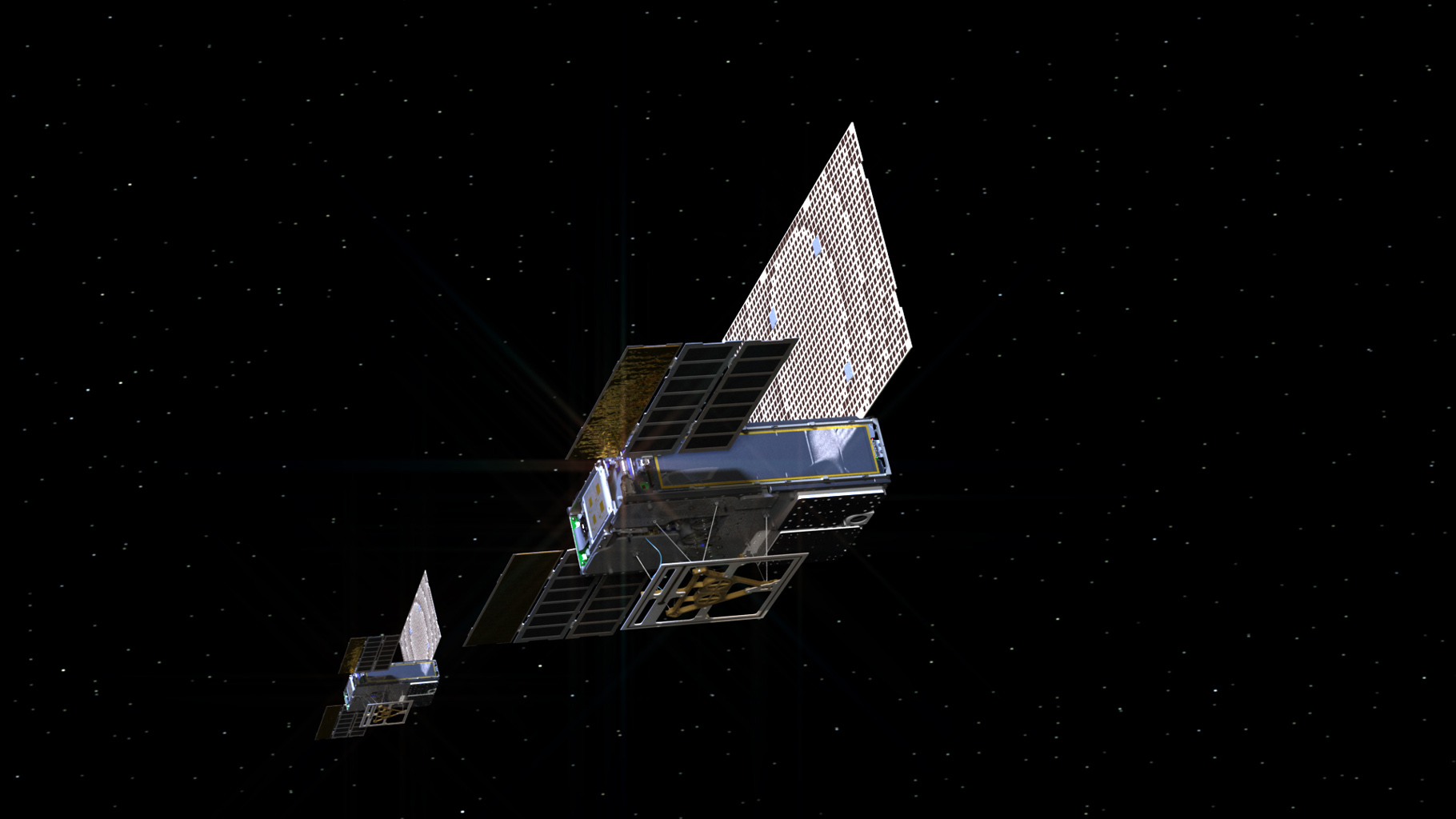
Artist’s impression of the twin Mars Cube One (MarCO) satellites making their way through deep space. Credit: NASA/JPL-Caltech
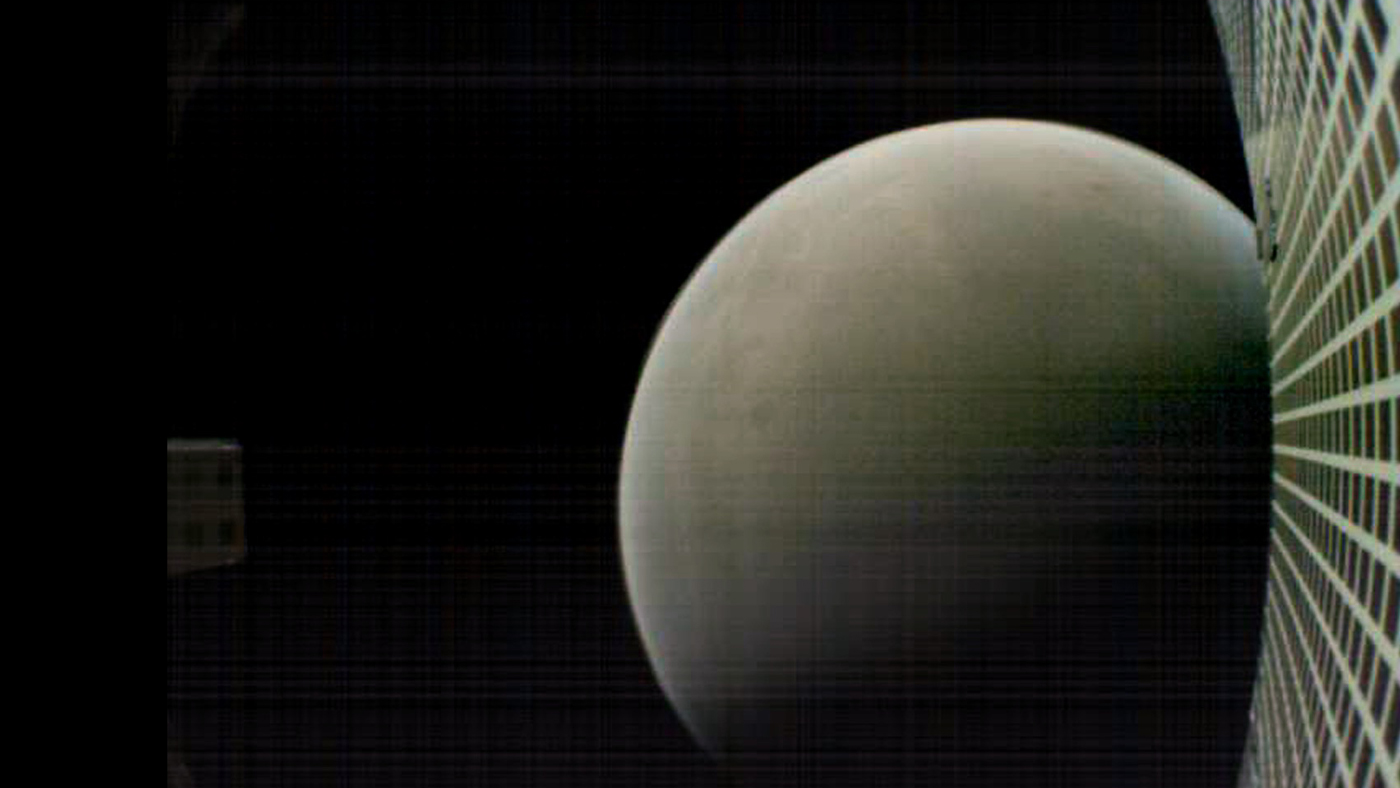
MarCO-B, one of the experimental Mars Cube One (MarCO) CubeSats, took this image of Mars during its flyby of the Red Planet on Nov. 26th, 2018. Credits: NASA/JPL-Caltech
NASA's Mars Cube One, or MarCO, is heading to deep space to test a first-of-its-kind technology demonstration: near-real-time communication between Earth and Mars using CubeSats. Learn more about the MarCO mission at:
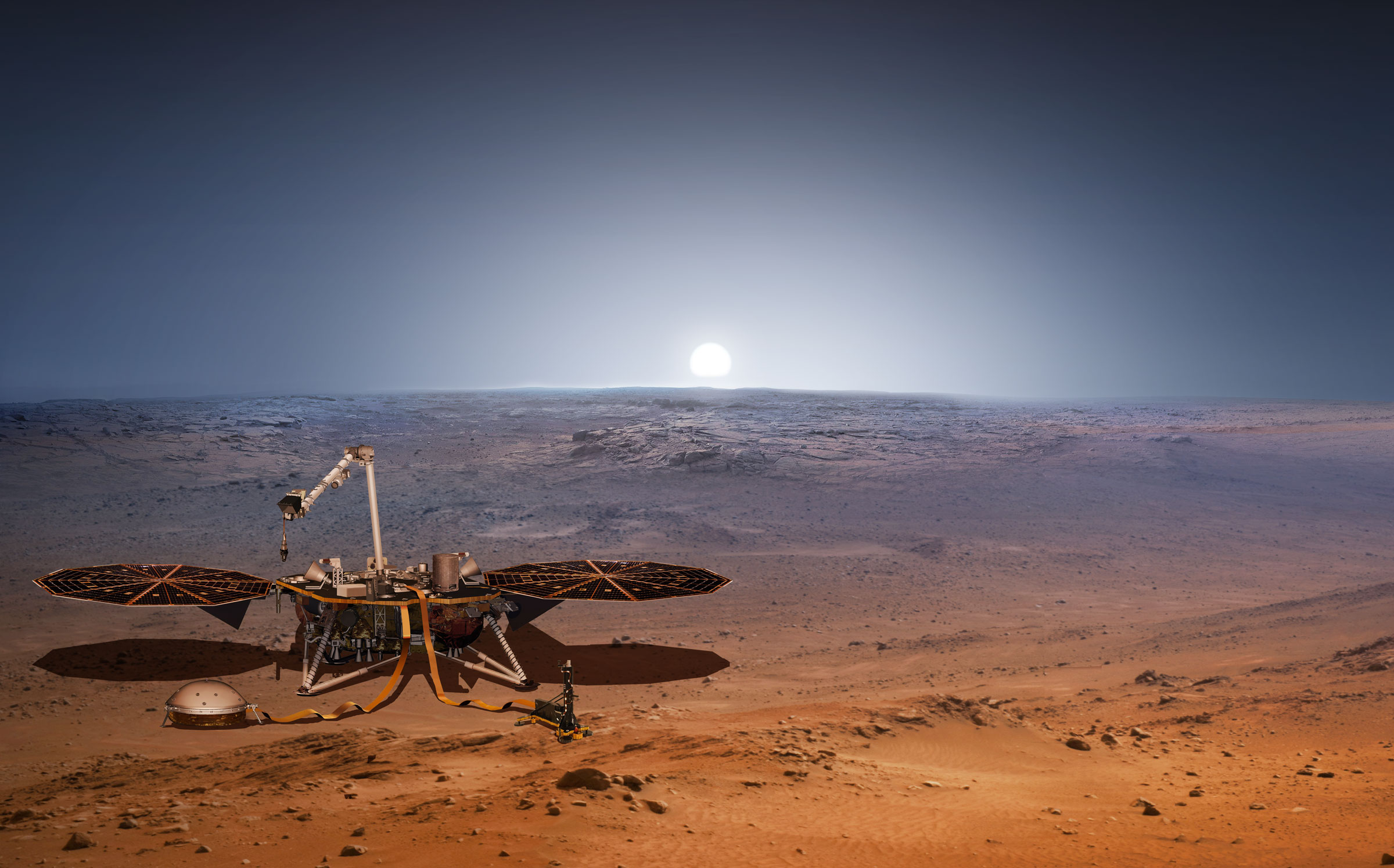
Artist’s interpretation of the InSight mission on the ground on Mars. Credit: NASA
This video and audio illustrates a seismic event detected by NASA's InSight on April 6, 2019, the 128th Martian day, or sol, of the mission. Three distinct kinds of sounds can be heard, all of them detected as ground vibrations by the spacecraft's seismometer, called the Seismic Experiment for Interior Structure (SEIS): There's noise from Martian wind; the seismic event itself; and the spacecraft's robotic arm as it moves to take pictures. This event is the first likely marsquake recorded by the InSight team. Several other seismic events have been recorded but are much more ambiguous than this signal. The audio underscores just how seismically noisy the Martian surface can be and was produced from two sets of sensors included with SEIS. You can hear sounds from the Very Broad Band sensors from your left speakers and sounds from the Short Period sensors from your right speakers. Audio from both sets of sensors have been sped up by a factor of 60; the actual vibrations on Mars would not have been audible to the human ear. Playback on headphones or speaker system recommended for best experience. For more about the mission, please visit Credit: NASA/JPL-Caltech/CNES/IPGP/Imperial College London
NASA's next mission to Mars is weeks away from its May 2018 launch. InSight is more than a Mars mission. Its team members hope to unlock the mysteries of the formation and evolution of rocky planets, including Earth. For more about the mission, visit
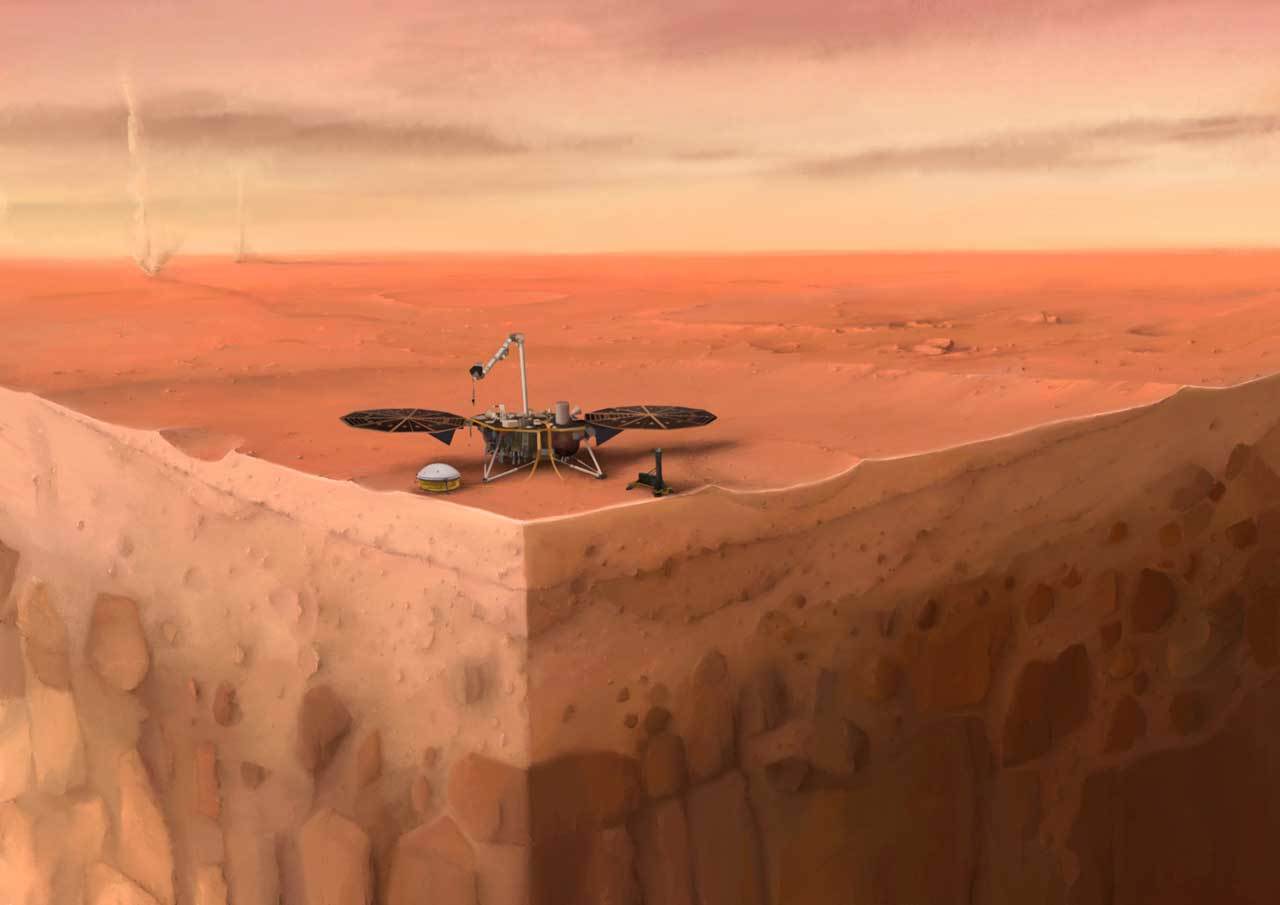
When NASA’s Interior Exploration using Seismic Investigations, Geodesy and Heat Transport (Insight) lander set down on Mars in November of 2018, it began its two-year primary mission of studying Mars’ seismology and interior environment. And now, just over a year and a half later, the results of the lander’s first twelve months on the Martian surface have been released in a series of studies.
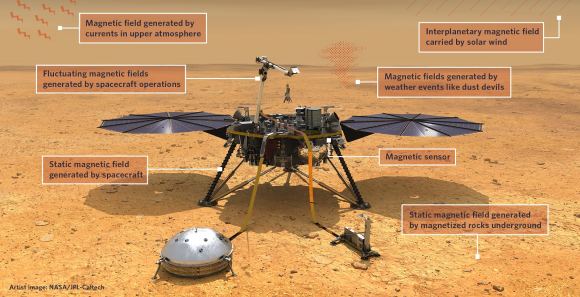
Sources of magnetism detected by magnetic sensor aboard the Mars InSight Lander. Credit: NASA/JPL-Caltech
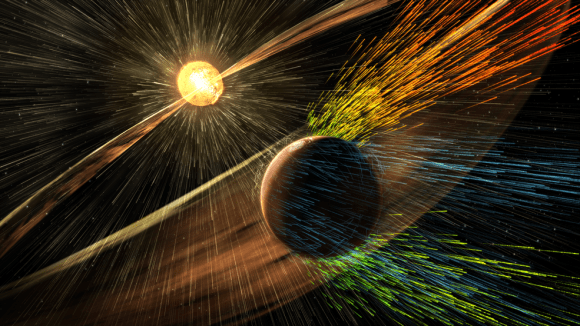
Artist’s rendering of a solar storm hitting Mars and stripping ions from the planet’s upper atmosphere. Credits: NASA/GSFC
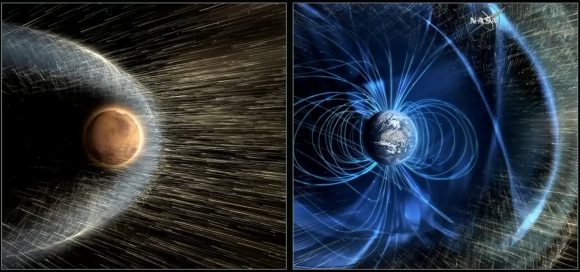
Artist’s impression of the interaction between solar wind and the planets Mars (left) and Earth (right). Credit: NASA
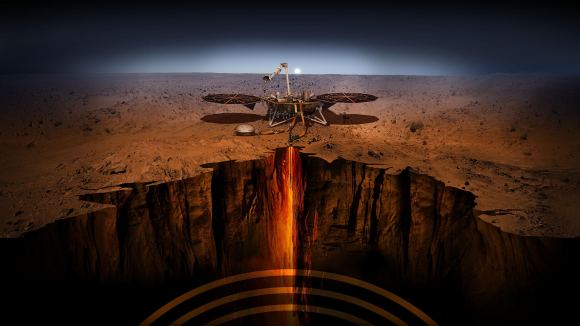
Artist’s concept of InSight “taking the pulse of Mars”. Credit: NASA/JPL-Caltech
NASA's next mission to Mars is weeks away from its May 2018 launch. InSight is more than a Mars mission. Its team members hope to unlock the mysteries of the formation and evolution of rocky planets, including Earth. For more about the mission, visit Category
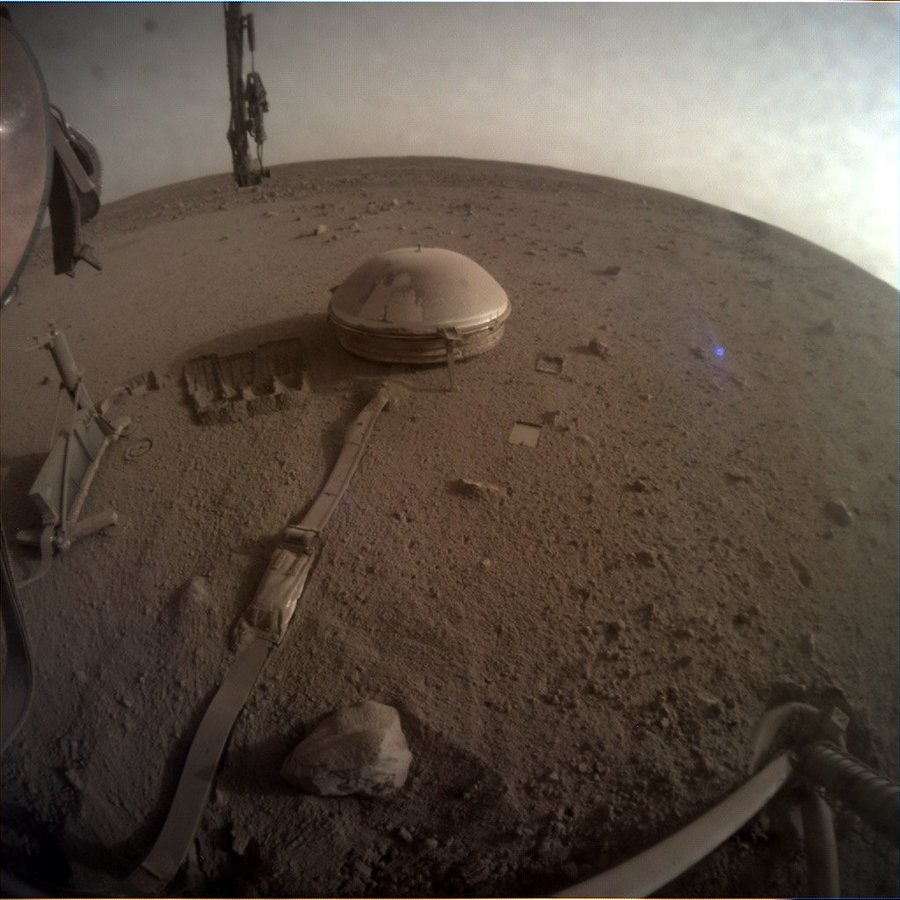
This image shows InSight's landing spot and its SEIS instrument, covered with its protective wind shield. The lander's been having trouble generating electricity and this could be its final image. Image Credit: NASA/JPL
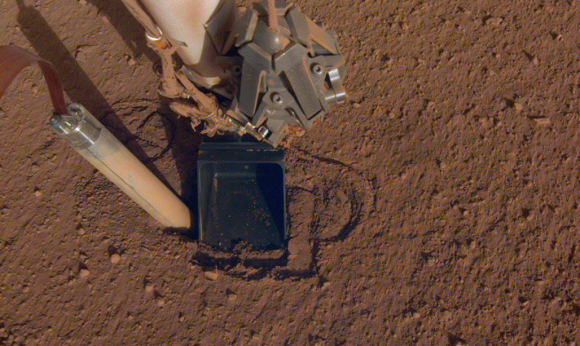
This image shows the difficulty that InSight’s Heat Probe (HP3) faced. Due to the nature of Martian regolith, it kept popping out of its hole. In this image, mission operators tried using the lander’s scoop to press on the probe’s hole. They hoped that would provide the friction necessary for the hammering action to be effective. Image Credit: NASA/JPL-Caltech
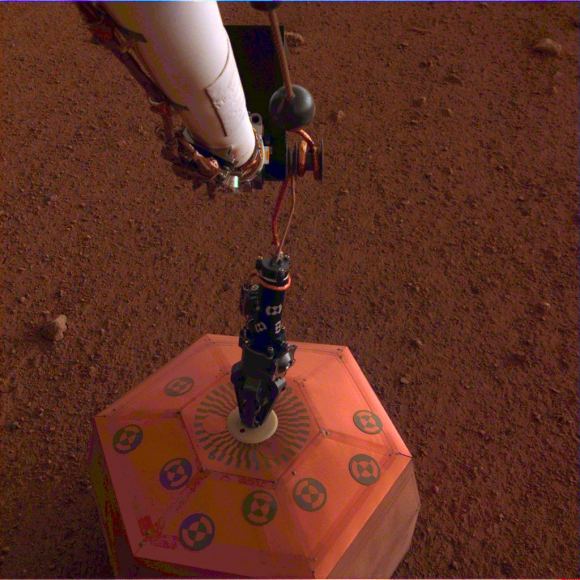
NASA’s InSight lander placed its seismometer onto Mars on Dec. 19, 2018. This was the first time a spacecraft robotically placed a seismometer onto the surface of another planet. Image Credit: NASA/JPL-Caltech
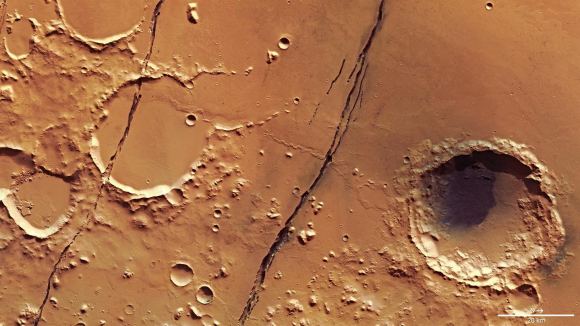
This image is a vertical plan view of Cerberus Fossae. The pair of trenches are very young and formed from volcanic activity only a few million years ago. Image Credit: ESA/DLR/FU Berlin, CC BY-SA 3.0 IGO
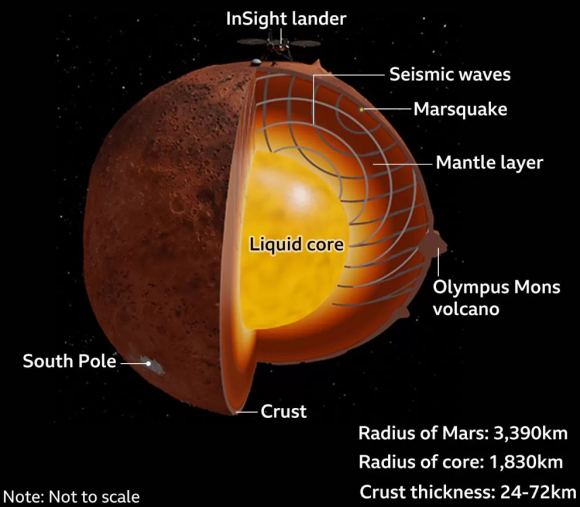
By reading how vibrations from impacts and Marsquakes travelled through the planet, SEIS gave scientists the data they needed to understand Mars’ interior structure. Image Credit: S. Cottaar, P. Koelemeijer, J. Winterbourne, NASA.
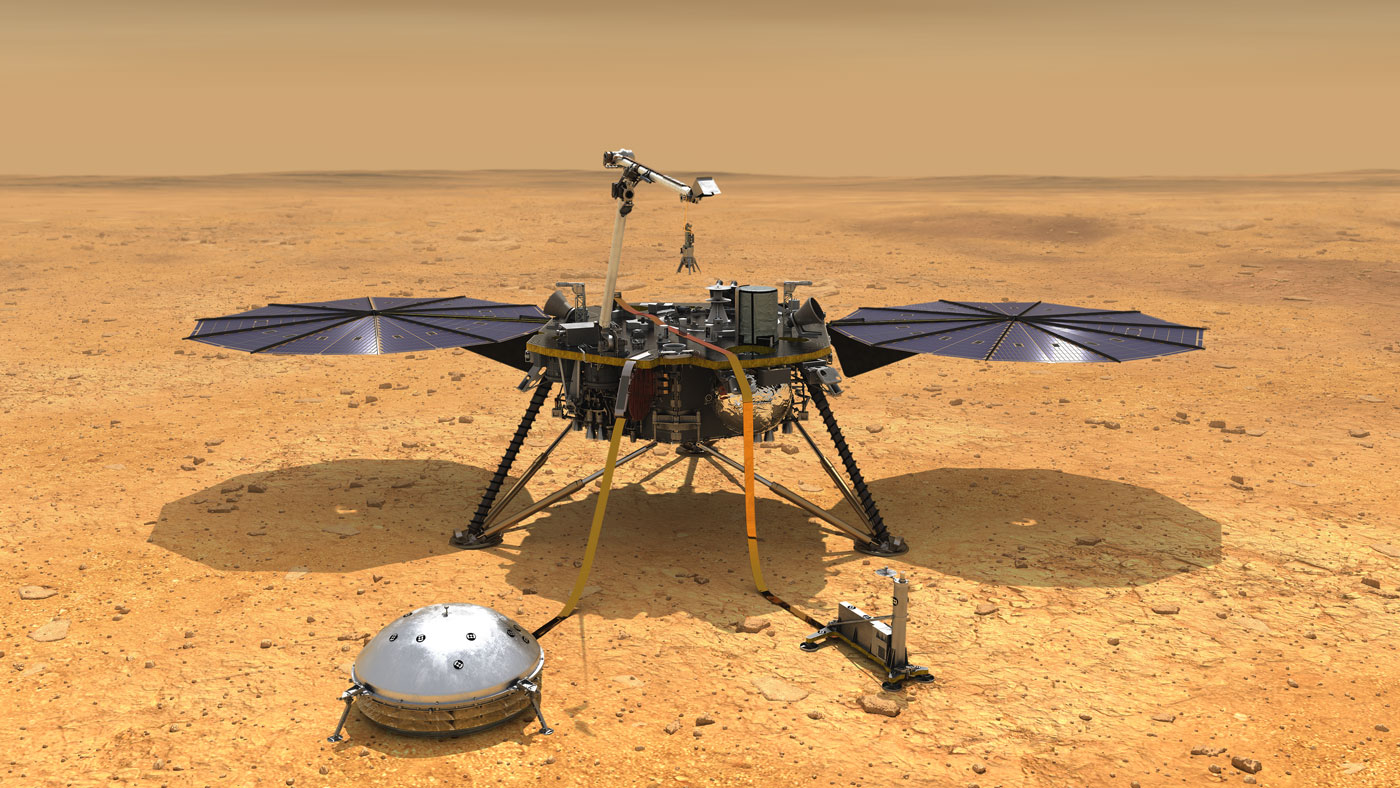
Artist illustration of Mars Insight Lander. Credit: NASA/JPL
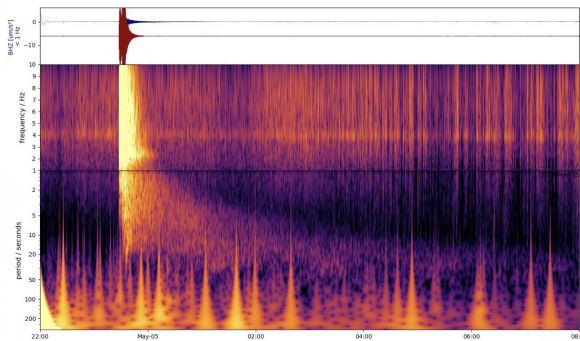
This spectrogram shows the largest quake ever detected on another planet. Estimated at magnitude 5, this quake was discovered by NASA’s InSight lander on May 4, 2022, the 1,222nd Martian day, or sol, of the mission. Credit: NASA/JPL-Caltech/ETH Zurich

InSight’s seismometer, SEIS, the Seismic Experiment for Interior Structure. Credit: NASA/JP